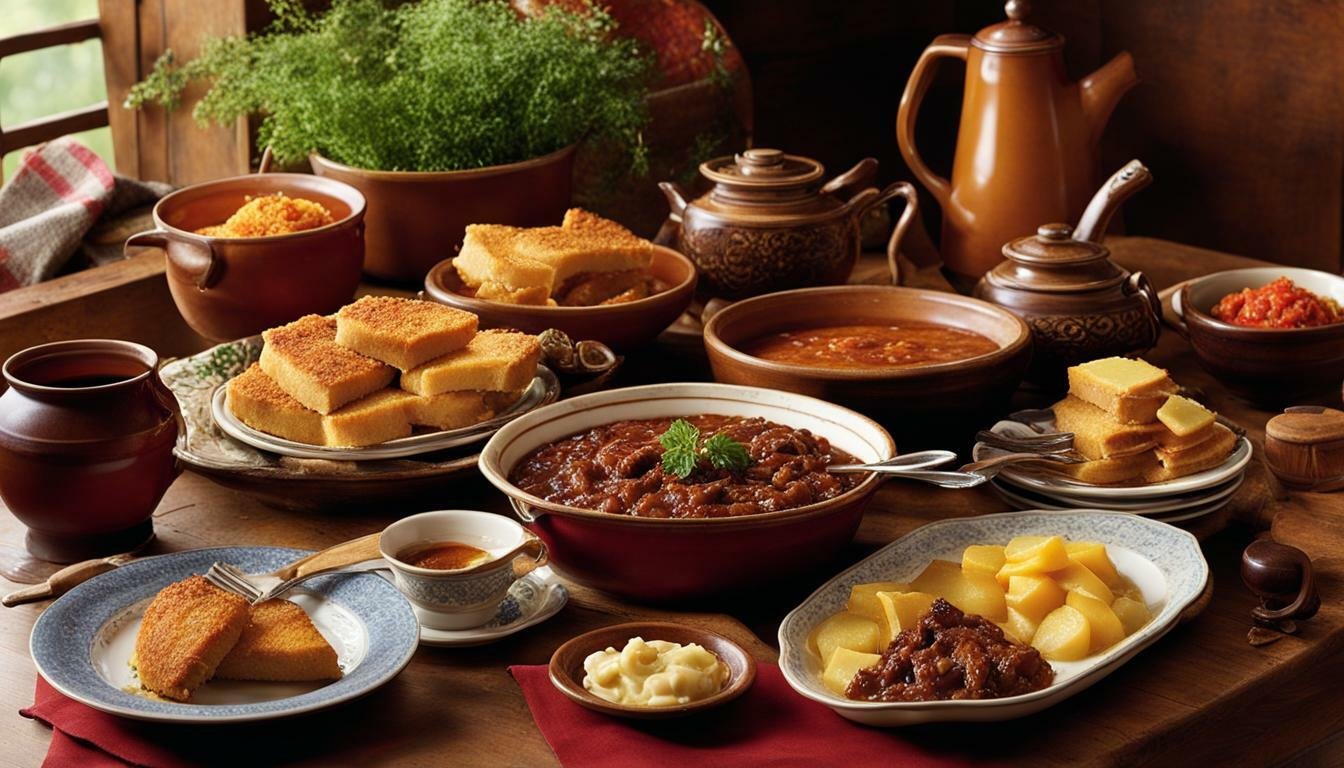Take Me to the Recipes
Imagine yourself amidst snow-capped mountains, the aroma of warm spices swirling through bustling bazaars. Close your eyes and picture heaping plates of colorful dishes, each a testament to Afghanistan’s rich history and diverse culinary tapestry. This isn’t just a daydream; it’s your invitation to discover Afghanistan through the magic of its food.
Forget the stereotypes and travel beyond the headlines. In this article, we’ll embark on a culinary journey unlike any other, guided by authentic Afghan recipes passed down through generations. Prepare to tantalize your taste buds with:
- Succulent kebabs: Marinated to perfection and grilled over open flames, each bite bursting with juicy flavor and aromatic spices.
- Hearty stews: Simmering with warmth and infused with fragrant herbs, these comforting dishes will transport you to cozy Afghan homes.
- Lush, layered rice dishes: A symphony of textures and flavors, Afghan rice dishes are an art form, showcasing the region’s culinary ingenuity.
- Delectable flatbreads: From the pillowy softness of naan to the flaky layers of tandoori bread, Afghanistan’s flatbreads are the perfect foundation for every meal.
- Sweet temptations: Don’t forget the finale! Luscious desserts like baklava and rice pudding will satisfy your sweet tooth with exotic flavors.
But Afghan cuisine is more than just delicious food; it’s a window into the soul of a nation. As you explore these recipes, you’ll uncover stories of resilience, hospitality, and cultural pride woven into every dish. Join us on this delicious adventure, discover the heart of Afghanistan, and unlock a world of unforgettable flavors waiting to be explored in your own kitchen.
Ready to embark on your culinary journey? Dive into our collection of authentic Afghan recipes and taste the magic of this captivating land for yourself!
Take Me to the Recipes
Afghan Cuisine – Key Takeaways:
- Afghanistan cuisine and recipes offer a delicious and authentic taste experience
- Afghan food is deeply rooted in cultural traditions and heritage
- From hearty meat dishes to fragrant spices, Afghan cuisine is known for its bold flavors and unique cooking techniques
- Traditional Afghan dishes like Kabuli Pulao and Mantu are beloved by food lovers worldwide
- You can bring the flavors of Afghan cuisine into your own kitchen with our tips and tricks
Where is Afghanistan?

Afghanistan is located in Central Asia with Iran to the west and Pakistan to the east.

Index to the Contents
- Take Me to the Recipes
- More Articles
- Interesting Facts About Afghanistan
- Afghanistan’s History and the Affect It Has Had on the Cuisine
- What impact has the Climate and Geography had on Afghan Cuisine?
- The Essence of Afghan Cuisine
- The Flavors of Afghan Cuisine
- Cooking Techniques in Afghan Cuisine
- What Makes Afghan Cuisine Unique?
- The Afghan Kitchen: A Place of Hospitality
- Exploring the Influence of Afghan Cuisine on the World
- Staple Ingredients in Afghan Cuisine
- Exploring Afghan Street Food Delights
- Afghanistan National Dish
- Traditional Afghan Dishes That Tempt the Taste Buds
- How Healthy is Afghan Food?
- Bringing Afghan Flavors to Your Kitchen
- Conclusion
- FAQ’s
You may also be interested in the Following Articles
- North and South American Cuisine – A Culinary Expedition
- Europe Cuisine: Savor the Continent’s Best Culinary Secrets!
- African Cuisine: Discover the Bold Flavors & Global Charm!
- Asian Cuisine Unlock its Secrets – Taste, Health & Global Influence!
Savor iconic Afghanistan Recipes – Click on each tantalizing Image to open up the Recipe!
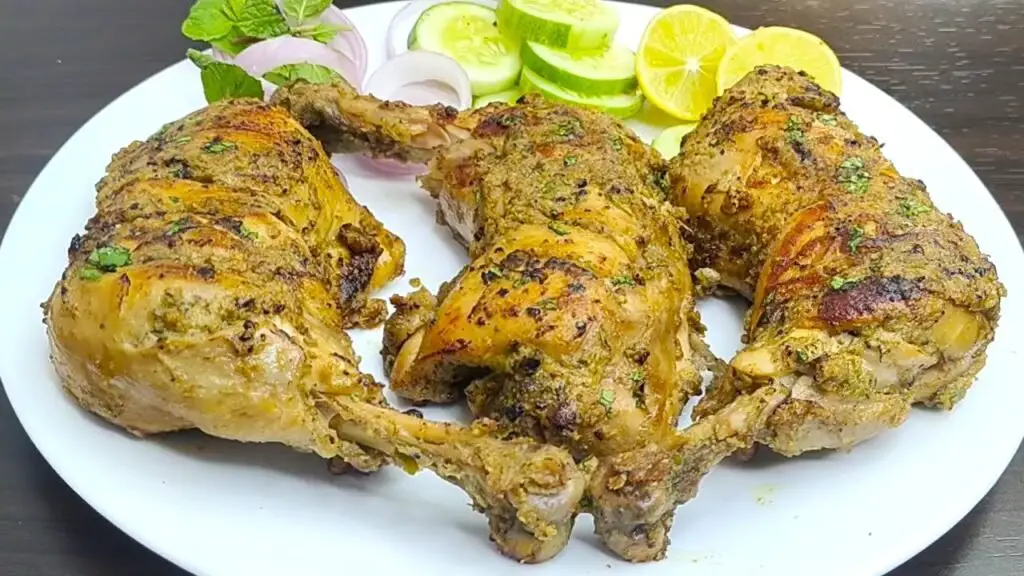

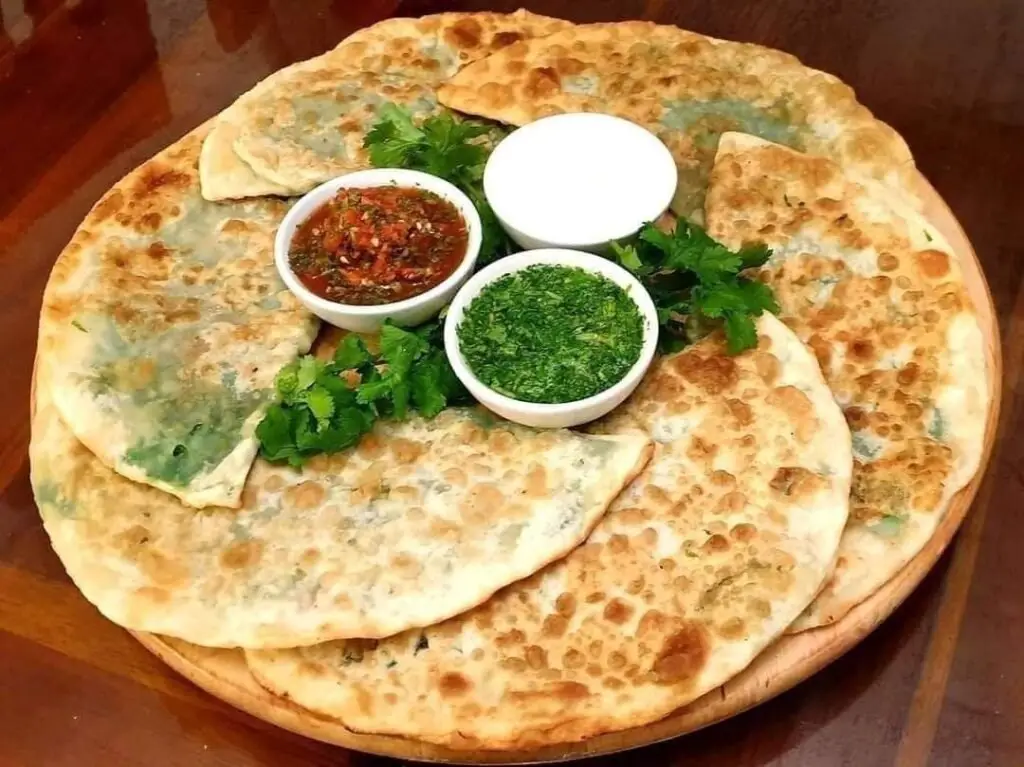

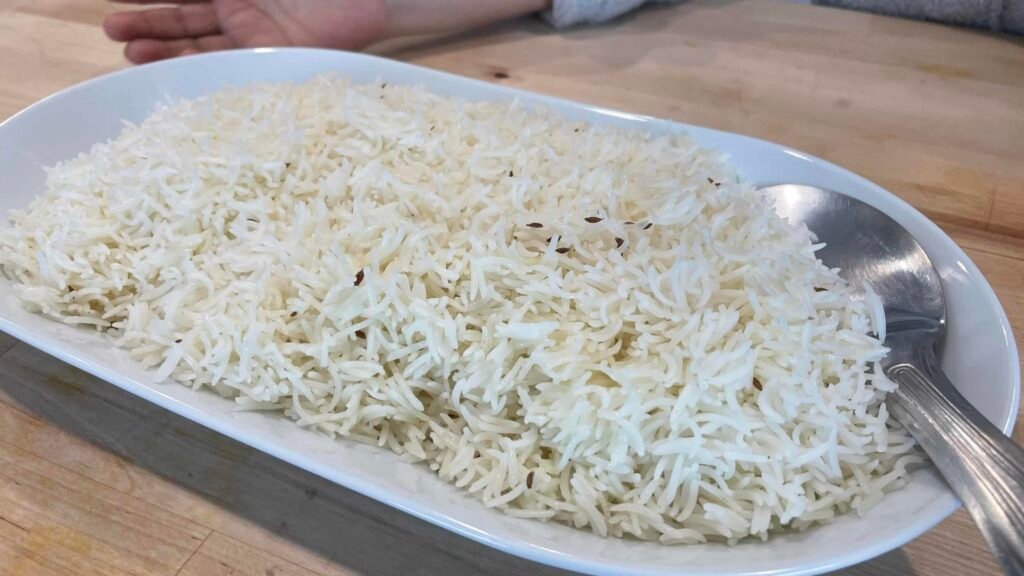
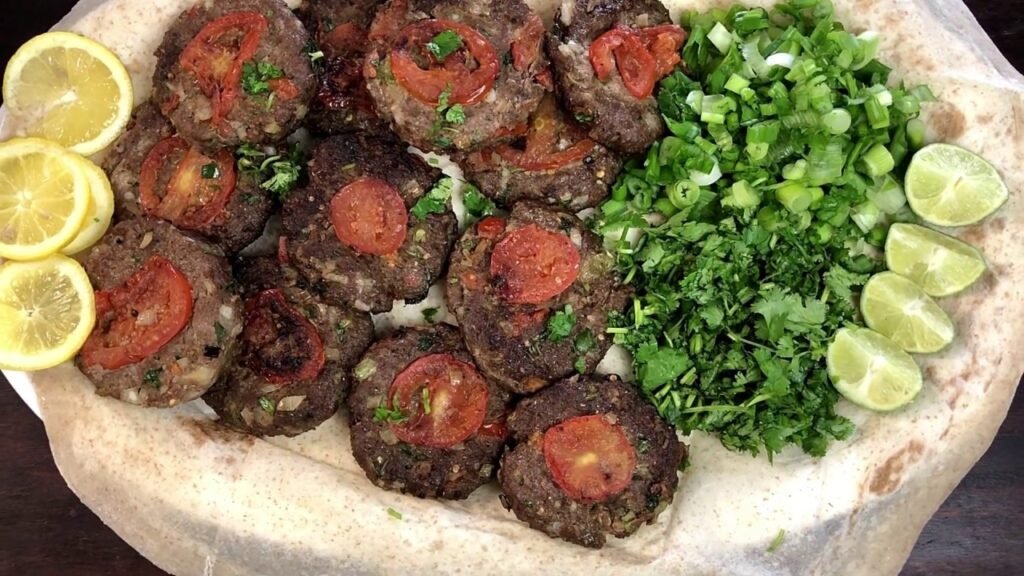
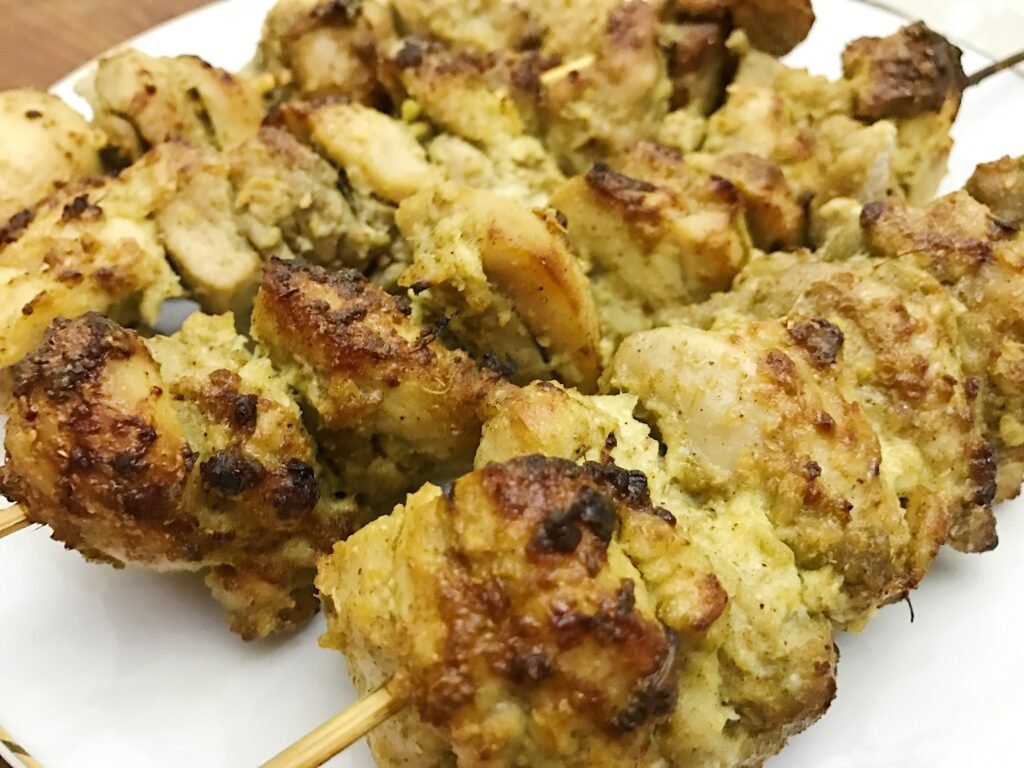

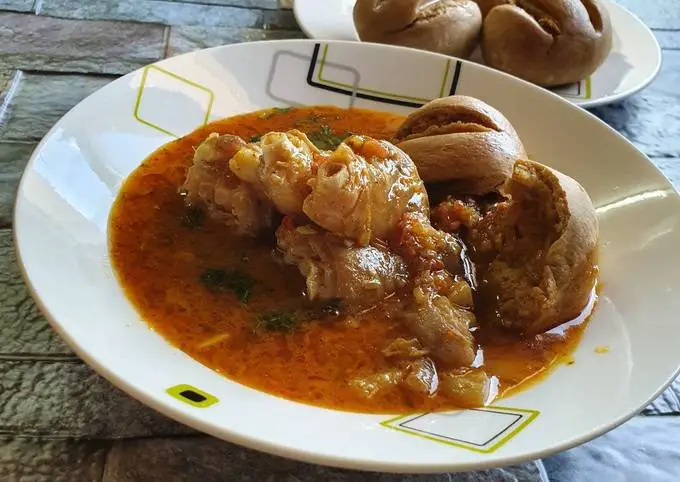
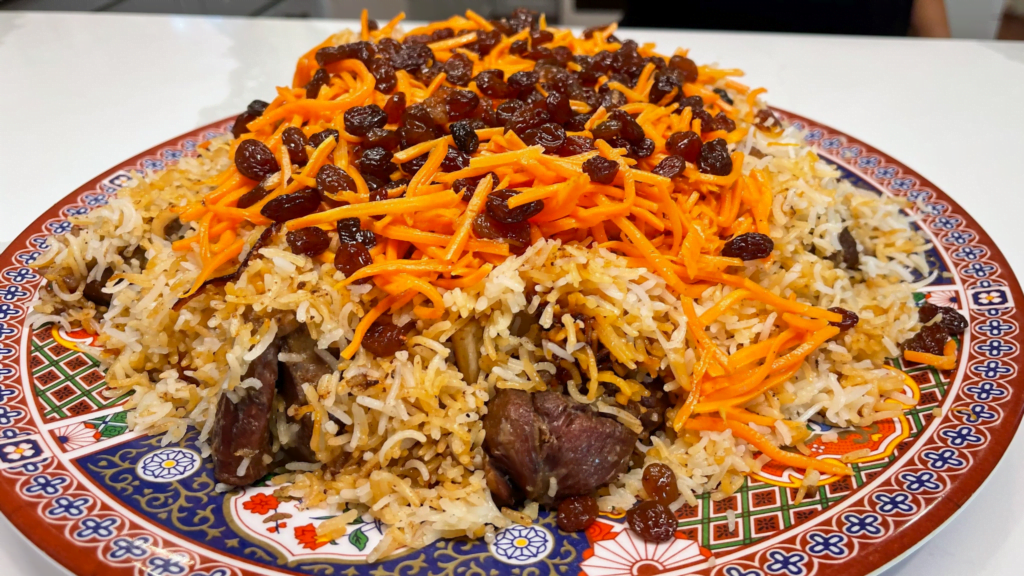



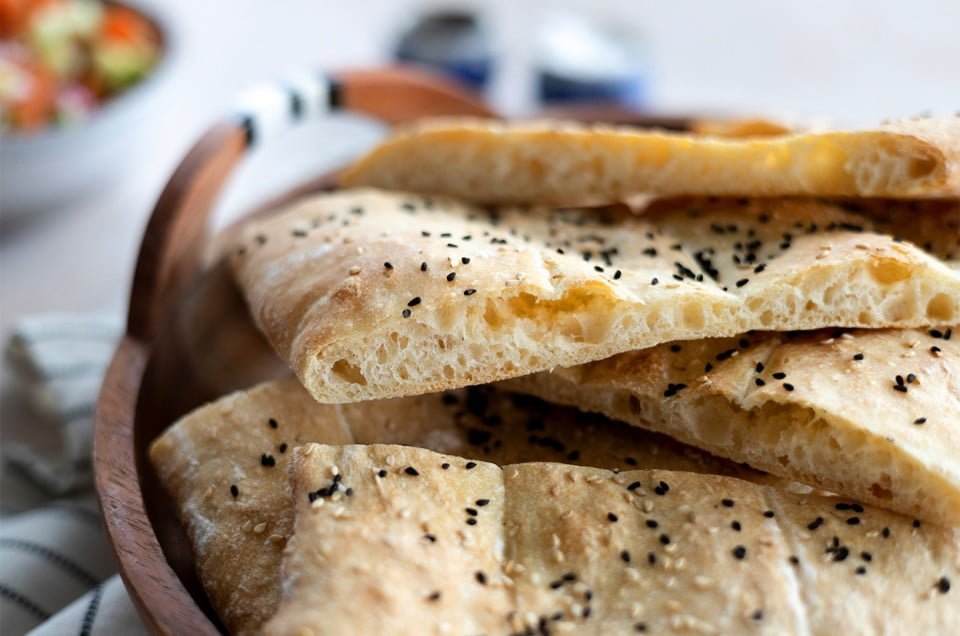
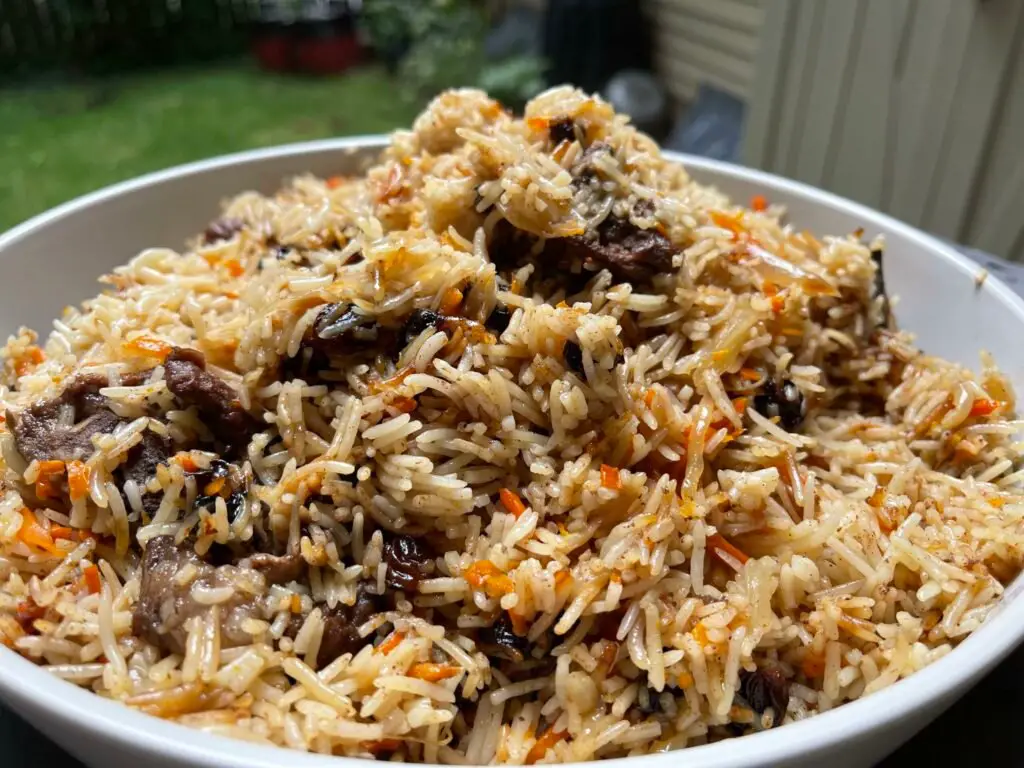



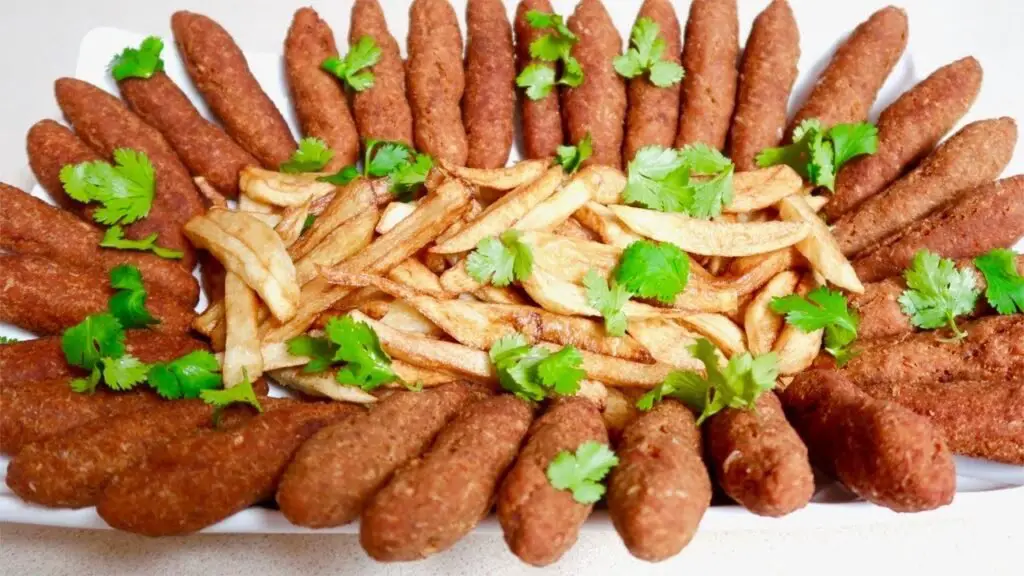

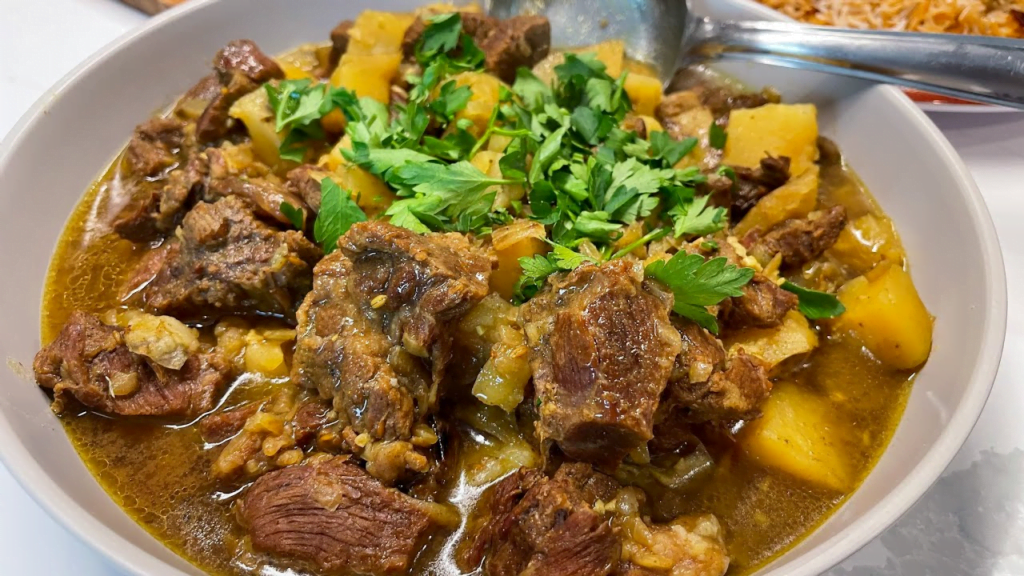

Interesting Facts About Afghanistan
Afghan – National Sport

Afghanistan is known for its passion for buzkashi, a traditional sport played on horseback. In buzkashi, riders compete to grab and secure a goat carcass and carry it to a goal, showcasing strength and horsemanship.
Pistachio Capital
Afghanistan is one of the world’s largest producers of pistachios. The country’s pistachios are highly regarded for their quality and taste, contributing to the global market.
Blue Mosque

Herat, a city in western Afghanistan, is home to the Blue Mosque (Goharshad Mosque), renowned for its stunning blue tiles. Legend has it that the mosque’s color is due to a mysterious woman who wept tears of ultramarine, adding to its mystique.
Buzkashi Goats
In buzkashi, the goat used for the game is typically disemboweled, making it challenging for the riders to hold on to. This tradition adds an unusual aspect to the already intense sport.
Ancient City of Balkh

Balkh, one of the world’s oldest cities, is located in northern Afghanistan. It is believed to have been continuously inhabited for over 5,000 years and is associated with various historical and religious figures.
Historical Buddhas
Afghanistan was home to the Buddhas of Bamiyan, two monumental statues carved into the cliffs of Bamiyan Valley. Unfortunately, they were destroyed by the Taliban in 2001, sparking global outrage.
Kabul’s Street of Books

Shahre Naw, or the Street of Books, in Kabul is famous for its vibrant book market. Despite challenges, the street has maintained a lively atmosphere, showcasing Afghanistan’s enduring love for literature.
Noshera Candy
Noshera, a popular candy in Afghanistan, is made from mulberries and traditionally enjoyed during the summer months. It is known for its sweet and slightly tangy flavor.
Opium Poppy Production (The Drug Trade)

Afghanistan is a major producer of opium poppy, which is used to make heroin. The cultivation of poppies has been a complex issue, intertwining with geopolitical and economic challenges in the region.
Land of Blue Burqas

Afghanistan gained the moniker “Land of Blue Burqas” due to the prevalence of blue burqas worn by Afghan women. The blue color is a traditional choice and is widely seen in the country.
Afghanistan’s History and the Affect It Has Had on the Cuisine

Afghanistan’s rich history has significantly influenced its cuisine, resulting in a diverse and flavorful culinary tradition that reflects the country’s cultural tapestry.
The cuisine of Afghanistan has evolved over centuries, shaped by various historical periods, invasions, migrations, and trade routes.
Ancient Influences (Before 500 BCE)
The early history of Afghanistan saw the region as a crossroads for ancient civilizations, including the Persian Empire, Indian subcontinent, and Central Asian cultures. This period laid the foundation for Afghan cuisine, introducing staples like rice, wheat, and various herbs and spices.
The Silk Road also played a crucial role in bringing diverse ingredients and culinary techniques to the region.
Persian and Greek Influence (500 BCE – 300 CE)

During the Achaemenid Empire and the subsequent Hellenistic period, Afghanistan was under the influence of Persian and Greek cultures. This period saw the introduction of kebabs, pilafs, and yogurt-based dishes into Afghan cuisine.
The use of aromatic spices, such as saffron, also became prevalent.
Islamic Rule and Central Asian Influence (7th – 18th Century)
With the advent of Islam in the 7th century, Afghan cuisine underwent further transformation. The Islamic dietary laws influenced cooking practices, and the region saw an increase in the use of lamb and mutton.
Central Asian flavors and techniques, such as dumplings and noodle dishes, also made their way into Afghan cuisine.
Mongol Invasions (13th – 14th Century)

The Mongol invasions brought new culinary elements to Afghanistan. The use of dairy products, particularly yogurt and various types of cheeses, became more widespread.
Mongolian-style dumplings, known as Mantu, found a place in Afghan cuisine, representing a fusion of Mongol and local culinary traditions.
Timurid Empire and Mughal Influence (15th – 18th Century)
Under the Timurid Empire, Afghanistan experienced cultural and culinary flourishing. The influence of the Mughals, who ruled parts of the Indian subcontinent, brought flavors like cardamom, cloves, and dried fruits to Afghan cuisine.
The Mughal culinary legacy is evident in dishes like Kabuli Pulao and various kebabs.
Modern Period (19th Century Onward)
The 19th and 20th centuries saw Afghanistan undergoing geopolitical changes, including British and Soviet interventions. Despite the turmoil, Afghan cuisine retained its authenticity and continued to evolve.
The use of rice, meat, and spices remains central, with regional variations reflecting local ingredients and preferences.
What impact has the Climate and Geography had on Afghan Cuisine?

Afghan cuisine is deeply influenced by the country’s diverse climate and varied geography, which range from high mountain ranges to arid plains. The unique terrain affects the availability of ingredients, agricultural practices, and cooking methods, shaping the flavors and characteristics of Afghan dishes.
Climate and Agriculture
Highland Agriculture:
Afghanistan’s mountainous regions, including the Hindu Kush and Pamir ranges, are conducive to the cultivation of hardy crops such as wheat and barley.
These high-altitude areas contribute to the production of grains that form the foundation of many Afghan dishes, including various types of bread and pilafs.
Irrigation in Lowland Areas
Lowland regions, particularly along river valleys such as the Kabul River, benefit from irrigation practices. This allows for the cultivation of a wider variety of crops, including fruits, vegetables, and legumes.
The availability of water supports the growth of pomegranates, melons, and a range of herbs, adding depth and freshness to Afghan cuisine.
Impact of Geography on Ingredients
Meat as a Staple:
The diverse geography of Afghanistan provides ample grazing land for livestock. As a result, meat, particularly lamb and mutton, is a staple in Afghan cuisine.
Kebabs, slow-cooked stews, and grilled meats are common dishes, reflecting the availability of high-quality, locally sourced meat.
Diverse Flora
Afghanistan’s diverse landscape influences the availability of wild plants and herbs. Many Afghan dishes incorporate locally foraged herbs like coriander, mint, and dill, adding aromatic and fresh flavors to the cuisine.
Cooking Methods and Techniques:
Slow Cooking in Harsh Climates
The harsh climate in parts of Afghanistan, characterized by extreme temperatures, has led to the development of slow-cooking techniques.
One prominent example is the preparation of slow-cooked stews, allowing tough cuts of meat to become tender and flavorful over extended cooking times.
Bread Making
The mountainous terrain has influenced the prevalence of bread in Afghan cuisine. Flatbreads, such as naan and bolani, are popular and are often baked on open flames.
The use of tandoor ovens in some regions is a testament to the resourcefulness of Afghan cooks adapting to their terrain.
Preservation Techniques
In regions with arid climates, preserving food becomes essential. Afghan cuisine incorporates drying and fermenting techniques for ingredients like fruits and vegetables, enabling their use throughout the year. Examples include dried fruits in pilafs and fermented yogurt-based sauces.
The Essence of Afghan Cuisine

As a food enthusiast, Afghan cuisine has always fascinated me. The flavors, colors, and aromas of Afghan dishes are unlike anything else I’ve tasted. Afghan cooking is an art, steeped in centuries-old traditions that have been passed down through generations.
At the heart of Afghan culinary traditions lie the principles of hospitality, generosity, and community. Meals are meant to be shared, enjoyed with loved ones and strangers alike.
The Role of Afghan Cooking in Society
Afghan cooking plays an integral part in Afghan culture and society. It is a symbol of identity, a way of preserving traditions and customs, and a means of connecting with others.
In Afghanistan, cooking is typically done by women, who are often responsible for feeding large families and guests. The kitchen is not just a space for cooking but also a place where social connections are forged, stories are shared, and relationships are strengthened.
The Flavors of Afghan Cuisine

Afghan cooking is renowned for its bold, robust flavors, thanks to the use of fragrant spices and herbs like cumin, coriander, turmeric, and cardamom. Meat dishes are particularly popular in Afghan cuisine, with lamb, chicken, and beef featuring prominently.
Other staple ingredients include a variety of grains like rice, wheat, and barley, as well as legumes like chickpeas and lentils. Fresh herbs like cilantro, parsley, and mint are also used abundantly, adding a burst of freshness and color to dishes.
Cooking Techniques in Afghan Cuisine
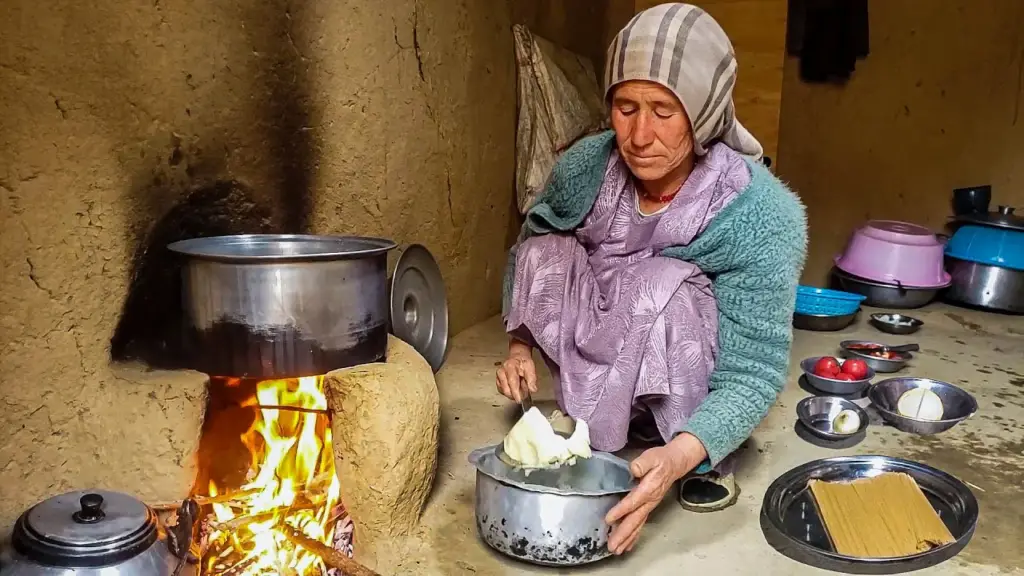
Afghan cooking involves a wide range of cooking techniques, from grilling and roasting to simmering and boiling. One technique that is particularly popular is stewing, which involves cooking meat and vegetables low and slow to create a rich, fragrant dish with tender meat and flavorful broth.
Another technique widely used in Afghan cooking is Tandoor cooking, which involves cooking bread and meat in a clay oven called a Tandoor. The intense heat of the oven results in smoky, charred flavors and crispy exteriors.
What Makes Afghan Cuisine Unique

What makes Afghan cooking truly unique is the fusion of flavors and techniques from neighboring regions and cultures. Thanks to years of trade and migration, Afghan cuisine has been shaped by Persian, Indian, and Central Asian influences, resulting in a rich and diverse culinary heritage.
Overall, Afghan cooking is a celebration of flavors, traditions, and community. It is an art form that has been passed down through generations, and one that continues to evolve and flourish.
The Afghan Kitchen: A Place of Hospitality

The Afghan kitchen is not merely a space for cooking but also a hub of hospitality and warmth. It holds a special place of importance in Afghan culture, as it symbolizes the heart and soul of a home. In fact, it is said that one can tell the character of an Afghan by the way they welcome guests into their kitchen.
As an Afghan, I have been fortunate to grow up in an environment where the kitchen is not just a place to cook but a space to bond with family and friends. It is a place where memories are made and stories are shared over a hot cup of chai.
When it comes to hospitality, Afghans are renowned for their generosity and warmth. It is considered an honor to be invited to an Afghan home for a meal, and guests are often greeted with open arms and a spread of delicious food. The traditional Afghan dining experience involves sitting on a floor cushion around a large communal platter, and sharing food as a way of bringing people together.
In the Afghan kitchen, preparing food is a labor of love that requires time and patience. From kneading dough for bread to slow-cooking stews, each step of the process is done with care and attention to detail. There is a certain pride that comes with cooking for others, and Afghans take pleasure in nourishing their loved ones with delicious meals.
The Afghan kitchen is not just a physical space but a symbol of the values that define Afghan culture: hospitality, generosity, and warmth. It is a place where tradition and modernity meet, and where the flavors of Afghanistan come to life.
Exploring the Influence of Afghan Cuisine on the World
Authentic Afghan cuisine has a rich and diverse culinary heritage that has influenced neighboring regions and beyond. The unique blends of spices, herbs, and ingredients in Afghan dishes have left an indelible mark on the global culinary scene, with their bold flavors and aromas.
The country’s traditional dishes, such as Kabuli pulao, Mantu, and Ashak, have gained popularity in the Western world due to their unique taste and cultural significance. Afghan restaurants are now thriving in cities across the globe, with chefs experimenting with new techniques and ingredients while staying true to the roots of Afghan cuisine.
Moreover, Afghan cuisine has also influenced the food cultures of neighboring countries such as Pakistan, India, and Iran. Many dishes, such as kebab, biryani, and pilaf, have their roots in Afghan cuisine and have been adapted over the years to suit local tastes and preferences.
Despite its global impact, Afghan cuisine remains rooted in its traditional cooking techniques and ingredients. Authentic Afghan cuisine is a celebration of flavors and culture, and we should take pride in preserving and promoting its legacy.
Staple Ingredients in Afghan Cuisine

When it comes to Afghan cuisine and recipes, spices are the key to creating rich and savory flavors. Afghan spices are typically a blend of aromatic spices like cardamom, cumin, coriander, and turmeric. These spices not only add depth and complexity to dishes but also provide several health benefits.
In addition to spices, grains play a central role in Afghan cuisine. Rice is a staple ingredient and is often served as a side dish or used as the base for popular dishes like Kabuli Pulao. Wheat is another essential grain used for making bread and noodles like the popular Mantu dumplings.
Another important ingredient in Afghan cooking is meat, typically lamb or beef. Meat dishes are often slow-cooked with fragrant spices and served with rice or bread. Vegetables like eggplant and potatoes are also commonly used in Afghan recipes, adding a hearty and filling component to many dishes.
Overall, the blend of fragrant spices and hearty grains and meats creates a unique and delicious culinary experience that is representative of Afghan cuisine. To explore the flavor profiles further, let’s take a closer look at some of the traditional Afghan dishes that utilize these staple ingredients.
Exploring Afghan Street Food Delights
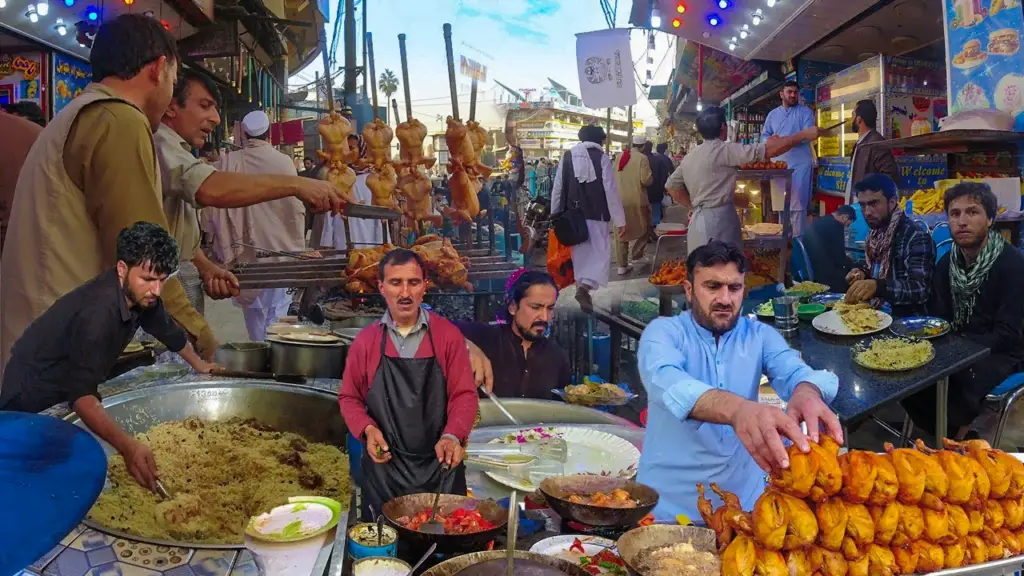
One of the best ways to experience the authentic taste of Afghanistan is by sampling its street food. In every corner of Afghanistan, you can find an array of savory and sweet snacks that will leave your taste buds begging for more. From the classic staple of Bolani (stuffed flatbread) to the sweet delight of Jalebi (syrup-soaked pastries), Afghan street food is a sensory experience that you won’t want to miss.
Among the most popular street food dishes is the delicious Kabob, a succulent skewer of marinated meats grilled to perfection and served with fresh bread and chutney. The tender and juicy meat is a result of the unique cooking technique used by Afghan street vendors, which involves smoldering coals and a special spice blend.
Another popular street food dish is the flavorful Samosa, a crispy pastry filled with spiced potatoes, peas, and meat. The savory filling is packed with aromatic flavors that are sure to leave you speechless.
For those with a sweet tooth, Afghan street food has plenty to offer. Try the mouth-watering Jalebi, a crispy golden pastry soaked in a sweet syrup and sprinkled with pistachios. Or, indulge in the sweet and nutty Sheer Yakh, a traditional Afghan ice cream made with rosewater and pistachios.
Afghanistan National Dish

Kabuli Pulao is the Afghan national dish. It is a flavorful rice dish cooked with meat, vegetables, and aromatic spices.
This traditional Afghan dish is often garnished with raisins, carrots, and almonds, giving it a unique and delightful taste.
Traditional Afghan Dishes That Tempt the Taste Buds
Get ready to tantalize your taste buds with some of the most beloved Afghan dishes. Afghan cuisine is characterized by bold flavors and unique cooking techniques, making it a sought-after cuisine for food lovers worldwide.
From the hearty national dish of Kabuli Pulao to the flavorful kebabs and comforting soups, there’s something for everyone to enjoy in Afghan cuisine.
How Healthy is Afghan Food?

Afghan cuisine, with its rich flavors and aromatic dishes, offers both taste and health benefits. Let’s explore why Afghan food is considered healthy:
Balanced Components
Afghan food includes essential components like carbohydrates, proteins, and fats. It features a variety of ingredients such as bread, rice, meats, and salads.
Yogurt, a common side dish or dip, adds probiotics and calcium to the meal.
Vegetables and Spices
Afghan cuisine incorporates a range of fresh vegetables, including eggplants, potatoes, cauliflower, turnips, and spinach.
The predominant flavors come from spices like cardamom, saffron, rose water, and orange peel.
Dishes like Qorma and Shorma showcase this delightful blend of flavors.
Bread and Rice
Afghan bread varieties include naan, chapati, and roghani naan, often cooked in clay ovens.
Opting for whole wheat flour instead of all-purpose flour makes the bread healthier.
Rice dishes like Chalow (fluffy white rice) and Qabeli Palow (slow-cooked rice with spices, raisins, and carrots) are specialties.
Lean Meats
Lamb, beef, and chicken are common meats in Afghan cuisine.
Slow-cooked and marinated preparations yield tender, juicy flavors.
Afghan kebabs, such as chicken kabob, chapli kebab, and Shami kabob, are popular choices.
- Borani Banjan:
- This mouth-watering vegetable dish features slices of fried eggplant simmered in an aromatic tomato sauce.
- It’s topped with thick garlic and mint-seasoned yogurt, often enjoyed with Afghan naan flatbread.
- Kabuli Pulao:
- The crown jewel of Afghan cuisine, Kabuli Pulao, combines steamed long-grained rice with almonds, caramelized carrots, raisins, and spiced meats (beef, chicken, or lamb).
- The blend of spices, including cardamom, cinnamon, and turmeric, adds depth to this flavorful dish.
Afghan food can be considered healthy when cooked properly with minimal oil, served in reasonable portions, and without unhealthy additives like sugar or MSG. So, savor the unique flavors of Afghan cuisine while keeping an eye on your calorie intake! 🥘🌱
References
- Afghan Cuisine Blog: Why Afghan Food is Healthy
- ArthurHenrys: Is Afghan Food Healthy?
- Lacademie: Afghan Food Guide
Bringing Afghan Flavors to Your Kitchen
Are you ready to try your hand at Afghan cooking? With a few key ingredients and some simple techniques, you can bring the authentic taste of Afghanistan into your own kitchen. Here are some tips to get you started:
Get the Right Spices
No Afghan dish is complete without a blend of fragrant spices. Stock up on essentials like cumin, coriander, cardamom, and turmeric to add depth and complexity to your dishes. You can find these spices at most grocery stores or specialty spice shops.
Afghan Food – Khajoor

Delightful Afghan Sweetness: Crafting Khajoor, Date-Filled Pastry
Embark on a sweet journey through Afghan flavors with Khajoor, a delectable pastry that encapsulates the rich sweetness of dates. Originating from Afghan kitchens, Khajoor is a beloved treat often enjoyed during festive occasions and celebrations.
Let’s delve into the history and art of making this delightful pastry that brings the warmth of Afghan hospitality to your home.
Afghan Food – Khajoor Ingredients
- 2 cups all-purpose flour
- 1 cup unsalted butter, softened
- 1/2 cup powdered sugar
- 1 teaspoon cardamom powder
- 1/2 cup milk
- 1 cup dates, pitted and chopped
- 1/2 cup chopped nuts (almonds, walnuts, or pistachios)
- Powdered sugar for dusting
Afghan Food – Khajoor Crafting Afghan Khajoor (Serving: 12-15 pieces)
Preparing the Dough:
- Mix Flour and Butter:
- In a bowl, combine all-purpose flour and softened butter, mixing until it forms a crumbly texture.
- Add Sugar and Cardamom:
- Incorporate powdered sugar and cardamom powder into the mixture, ensuring even distribution.
- Form Dough:
- Gradually add milk and knead the mixture into a soft, pliable dough. Cover and let it rest for 30 minutes.
Making the Date Filling:
- Prepare Date Mixture:
- In a separate bowl, mix chopped dates and chopped nuts to create the filling.
Assembling Khajoor:
- Rolling Out Dough:
- Roll out the rested dough into a thin sheet on a floured surface.
- Spread Date Filling:
- Evenly spread the prepared date and nut mixture over the rolled-out dough.
- Roll into Log:
- Carefully roll the dough into a log, ensuring the date filling is enclosed.
- Chill and Slice:
- Chill the rolled log in the refrigerator for at least 2 hours. Once firm, slice it into 1/2-inch rounds.
Baking Khajoor:
- Preheat Oven:
- Preheat your oven to 350°F (175°C).
- Bake Until Golden:
- Place the sliced Khajoor on a baking sheet and bake for 12-15 minutes or until they turn golden brown.
Finishing Touch:
- Dust with Powdered Sugar:
- Allow the Khajoor to cool and dust them with powdered sugar for a finishing touch.
Nutritional Information:
- Calories: Approximately 150 per serving (1 piece)
- Protein: 2g
- Fat: 8g
- Carbohydrates: 18g
- Fiber: 1g
- Sugar: 8g
- Sodium: 10mg
Savor the sweetness of Afghan hospitality with Khajoor, a delightful pastry that brings the flavors of dates and nuts together in a perfect harmony. This recipe invites you to experience the joy of creating a beloved Afghan treat that is both delicious and heartwarming.
Afghan Food – Gadda

A Culinary Delight from Afghanistan: Crafting Gadda, Sweet Rice Flour Dumplings
Embark on a journey into Afghan sweets with Gadda, a delightful treat that holds a special place in Afghan desserts. Originating from the rich culinary heritage of Afghanistan, Gadda is a sweet rice flour dumpling filled with delectable nuts and spices.
Join me in discovering the history and crafting this beloved Afghan dessert that brings a symphony of flavors to your table.
Afghan Food – Gadda Ingredients:
Dough:
- 1 cup rice flour
- 1/2 cup water
- 1 tablespoon ghee (clarified butter)
- 1/4 teaspoon cardamom powder
Filling:
- 1/2 cup chopped mixed nuts (almonds, walnuts, and pistachios)
- 2 tablespoons desiccated coconut
- 3 tablespoons powdered sugar
- 1/2 teaspoon cardamom powder
Frying:
- Vegetable oil for deep frying
Afghan Food – Gadda Crafting Afghan Gadda (Serving: 10-12 pieces)
Preparing the Dough:
- Mix Rice Flour and Water:
- In a bowl, combine rice flour and water to form a smooth batter.
- Add Ghee and Cardamom:
- Stir in ghee and cardamom powder into the batter, ensuring a well-incorporated mixture.
Making the Filling:
- Prepare Nut Mixture:
- In a separate bowl, mix chopped nuts, desiccated coconut, powdered sugar, and cardamom powder to create the sweet nut filling.
Assembling Gadda:
- Forming Dough Balls:
- Take small portions of the rice flour dough and roll them into small balls.
- Create Hollow Center:
- Press each dough ball with your thumb to create a hollow center for the filling.
- Add Nut Filling:
- Spoon the sweet nut mixture into the hollow center of each dough ball, sealing the edges to form dumplings.
Frying Gadda:
- Heat Vegetable Oil:
- Heat vegetable oil in a deep frying pan to 350°F (175°C).
- Deep Fry Until Golden:
- Carefully drop the filled dough balls into the hot oil and deep fry until they turn golden brown.
- Drain Excess Oil:
- Remove the fried Gadda from the oil and place them on paper towels to drain excess oil.
Serve and Enjoy:
- Cool and Serve:
- Allow the Gadda to cool slightly before serving. Enjoy these sweet rice flour dumplings as a delightful treat!
Nutritional Information:
- Calories: Approximately 120 per serving (1 piece)
- Protein: 2g
- Fat: 7g
- Carbohydrates: 14g
- Fiber: 1g
- Sugar: 5g
- Sodium: 5mg
Savor the sweetness of Afghan tradition with Gadda, a treat that combines the delicate texture of rice flour with the richness of nutty sweetness. This recipe invites you to experience the joy of crafting a beloved Afghan dessert that is both simple and indulgent.
Afghan Food – Naan

Unveiling the Afghan Hearth: The Tradition of Naan Bread
In the heart of Afghan cuisine lies the beloved Naan bread, a staple that has been nourishing families for generations. Originating in the diverse landscapes of Afghanistan, Naan is a flatbread that reflects the country’s rich culinary history.
Traditionally baked in tandoor ovens, Naan is enjoyed with various accompaniments, from savory stews to aromatic kebabs. Let’s embark on a culinary journey to discover the art of making Afghan Naan.
Afghan Food – Naan Ingredients:
4 cups all-purpose flour
- 1 teaspoon sugar
- 1 teaspoon salt
- 1 teaspoon active dry yeast
- 1 cup warm water
- 1/4 cup plain yogurt
- 2 tablespoons vegetable oil
- Nigella seeds or sesame seeds for garnish (optional)
- Butter for brushing (optional)
Afghan Food – Naan Recipe: Crafting Afghan Naan (Serving: 6-8)
Preparing the Dough:
- Activate Yeast:
- In a bowl, mix warm water, sugar, and yeast. Let it sit for 5-10 minutes until frothy.
- Combine Dry Ingredients:
- In a large bowl, whisk together flour and salt.
- Mix Wet Ingredients:
- Add the activated yeast mixture, plain yogurt, and vegetable oil to the dry ingredients. Mix to form a soft dough.
- Knead and Rise:
- Knead the dough on a floured surface for 8-10 minutes until smooth. Place it in a greased bowl, cover, and let it rise for 1-2 hours or until doubled in size.
Shaping and Baking:
- Preheat Oven:
- Preheat your oven to its highest temperature (around 475°F or 245°C) with a pizza stone inside, if available.
- Divide and Shape:
- Divide the risen dough into 6-8 equal portions. Roll each portion into an oval or round shape, about 1/4 inch thick.
- Bake in Oven:
- Carefully transfer the rolled Naan onto the preheated pizza stone or baking sheet. Bake for 5-7 minutes or until puffed and golden brown.
- Optional Garnish:
- If desired, sprinkle Nigella seeds or sesame seeds over the Naan before baking for added flavor and visual appeal.
Finishing Touch:
- Brush with Butter:
- Optionally, brush the freshly baked Naan with melted butter to enhance its richness and flavor.
- Serve Warm:
- Serve the Naan warm with your favorite Afghan dishes, such as Kabuli Pulao or kebabs.
Nutritional Information:
- Calories: Approximately 200 per serving (1 Naan)
- Protein: 5g
- Fat: 3g
- Carbohydrates: 38g
- Fiber: 2g
- Sugar: 1g
- Sodium: 250mg
Embrace the warmth of Afghan hospitality by baking this delightful Naan bread at home. With its soft texture and fragrant aroma, Afghan Naan is not just a side dish but a cultural experience to be shared with loved ones.
Afghan Food – Chicken Kabob

Grilling Tradition: Afghan Chicken Kabob
In the heart of Afghan culinary traditions lies the aromatic delight of Chicken Kabob. Originating from the diverse landscapes of Afghanistan, this recipe captures the essence of Afghan hospitality and the love for flavorful grilled meats.
The combination of marinated chicken, fragrant spices, and open flame grilling creates a dish that’s both succulent and rich in cultural heritage. Join me on a journey to recreate this classic Afghan Chicken Kabob that brings the warmth of traditional Afghan cuisine to your table.
Afghan Food – Chicken Kabob Ingredients
2 pounds boneless, skinless chicken thighs, cut into chunks
- 1/4 cup plain yogurt
- 2 tablespoons olive oil
- 2 teaspoons ground coriander
- 2 teaspoons ground cumin
- 1 teaspoon turmeric
- 1 teaspoon paprika
- 1 teaspoon ground ginger
- 4 cloves garlic, minced
- Juice of 1 lemon
- Salt and pepper to taste
- Skewers, soaked in water
Afghan Food – Chicken Kabob Recipe: Grilling Afghan Chicken Kabob (Serving: 4-6)
Marinating the Chicken:
- Prepare Chicken:
- Cut chicken thighs into bite-sized chunks, ensuring uniform pieces for even cooking.
- Create Marinade:
- In a bowl, combine yogurt, olive oil, ground coriander, ground cumin, turmeric, paprika, ground ginger, minced garlic, lemon juice, salt, and pepper. Mix well to form a smooth marinade.
- Marinate Chicken:
- Place the chicken chunks in the marinade, ensuring each piece is well coated. Cover the bowl and refrigerate for at least 2 hours, allowing the flavors to infuse.
Grilling the Chicken Kabob:
- Preheat Grill:
- Preheat your grill to medium-high heat.
- Skewer Chicken:
- Thread marinated chicken chunks onto the soaked skewers, leaving a bit of space between each piece.
- Grill to Perfection:
- Grill the chicken kabobs for 10-15 minutes, turning occasionally, until the chicken is fully cooked with a golden-brown char on the outside.
- Serve Hot:
- Remove the chicken kabobs from the grill and let them rest for a few minutes. Serve hot, paired with Afghan flatbreads or rice.
Nutritional Information:
- Calories: Approximately 250 per serving (6 ounces of grilled chicken)
- Protein: 30g
- Fat: 12g
- Carbohydrates: 4g
- Fiber: 1g
- Sugar: 1g
- Sodium: 300mg
Indulge in the smoky and savory goodness of Afghan Chicken Kabob, a dish that encapsulates the vibrant flavors of Afghan grilling traditions. Gather your loved ones, fire up the grill, and savor the cultural richness of this classic Afghan recipe.
Afghan Food – Chapli Kebab

Sizzling Heritage: The Tale of Afghan Chapli Kebab
Embark on a gastronomic journey through the rugged terrains of Afghanistan as we delve into the history and flavors of Chapli Kebab. Originating from the Khyber Pakhtunkhwa region, this iconic Afghan dish has transcended borders, captivating taste buds with its blend of ground meat, aromatic spices, and a distinctive flat shape.
Join me in recreating this culinary masterpiece that mirrors the rich cultural tapestry of Afghanistan.
Afghan Food – Chapli Kebab Ingredients
- 1 pound ground beef or lamb
- 1/2 cup finely chopped onions
- 1/4 cup chopped fresh cilantro
- 1/4 cup chopped fresh mint
- 1/4 cup chopped green onions
- 1/4 cup finely chopped tomatoes
- 2 tablespoons ground coriander
- 1 tablespoon ground cumin
- 1 tablespoon red chili powder
- 1 teaspoon ground turmeric
- 2 teaspoons salt
- 1/2 cup chickpea flour
- 2 beaten eggs
- Vegetable oil for frying
Afghan Food – Recipe: Crafting Afghan Chapli Kebab (Serving: 4-6)
Preparing the Chapli Mixture:
- Combine Ground Meat:
- In a large bowl, mix ground beef or lamb with finely chopped onions, cilantro, mint, green onions, and tomatoes.
- Add Spices:
- Incorporate ground coriander, ground cumin, red chili powder, turmeric, and salt into the meat mixture. Ensure even distribution of spices.
- Integrate Binding Ingredients:
- Add chickpea flour and beaten eggs to the mixture. Mix thoroughly to create a cohesive blend that holds its shape.
Shaping and Frying:
- Shape Kebabs:
- Take a portion of the Chapli mixture and shape it into flat, round patties, approximately 3 inches in diameter.
- Heat Oil:
- In a skillet, heat vegetable oil over medium-high heat.
- Fry Chapli Kebabs:
- Carefully place the shaped Chapli kebabs in the hot oil, cooking each side for 3-4 minutes or until golden brown and cooked through.
- Drain Excess Oil:
- Once cooked, place the Chapli kebabs on paper towels to absorb any excess oil.
Serving and Enjoying:
- Garnish and Serve:
- Garnish the Chapli kebabs with additional chopped cilantro, mint, and green onions. Serve hot with naan or rice.
Nutritional Information:
- Calories: Approximately 300 per serving (2 Chapli kebabs)
- Protein: 20g
- Fat: 15g
- Carbohydrates: 20g
- Fiber: 3g
- Sugar: 2g
- Sodium: 800mg
Experience the bold flavors and cultural heritage of Afghanistan with Chapli Kebab. This dish, deeply rooted in tradition, offers a delectable journey for your taste buds, making it a perfect addition to your culinary repertoire.
Afghan Food – Shami Kabob

A Culinary Journey: Unwrapping the Story of Afghan Shami Kabob
Embark on a flavorful expedition through the aromatic world of Afghan cuisine with the tantalizing Shami Kabob. Originating from the diverse culinary landscape of Afghanistan, Shami Kabob boasts a rich history and is celebrated for its unique blend of ground meat, lentils, and fragrant spices.
Join me as we unravel the story behind this dish and recreate the magic of Afghan Shami Kabob in your own kitchen.
Afghan Food – Shami Kabob Ingredients
- 1 pound ground beef or lamb
- 1 cup split red lentils (masoor dal), soaked and drained
- 1 onion, finely chopped
- 2 cloves garlic, minced
- 1 teaspoon ground cumin
- 1 teaspoon ground coriander
- 1 teaspoon ground turmeric
- 1 teaspoon red chili powder
- 1 teaspoon garam masala
- Salt and pepper to taste
- 1 egg, beaten
- 1/2 cup fresh cilantro, chopped
- Vegetable oil for frying
Afghan Food – Recipe: Crafting Afghan Shami Kabob (Serving: 4-6)
Preparing the Shami Mixture:
- Soak Lentils:
- Soak the split red lentils in water for at least 2 hours. Drain well.
- Cook Lentils:
- In a pot, boil the soaked lentils until they are soft and easily mashed. Drain any excess water.
- Mixing Ground Meat:
- In a large bowl, combine ground beef or lamb with chopped onions, minced garlic, ground cumin, ground coriander, ground turmeric, red chili powder, garam masala, salt, and pepper.
- Add Lentils:
- Add the cooked lentils to the meat mixture. Mix well to combine.
Shaping and Frying:
- Blend and Form Patties:
- Use a food processor to blend the meat and lentil mixture until smooth. Shape the mixture into flat, round patties.
- Coat with Egg:
- Dip each patty in beaten egg, ensuring a thin coating on both sides.
- Pan-Fry Kabobs:
- In a pan, heat vegetable oil over medium-high heat. Pan-fry the Shami Kabobs until golden brown on both sides, approximately 3-4 minutes per side.
Serving and Enjoying:
- Drain and Garnish:
- Place the fried Shami Kabobs on paper towels to drain any excess oil. Garnish with fresh cilantro.
- Serve Hot:
- Serve the Shami Kabobs hot, either as a main dish or stuffed in naan bread for a delightful sandwich.
Nutritional Information:
- Calories: Approximately 250 per serving (2 Shami Kabobs)
- Protein: 18g
- Fat: 10g
- Carbohydrates: 20g
- Fiber: 6g
- Sugar: 2g
- Sodium: 600mg
Indulge in the savory charm of Afghan Shami Kabob, a dish that encapsulates the essence of Afghan culinary artistry. With its unique combination of spices and textures, Shami Kabob is sure to transport you to the vibrant kitchens of Afghanistan, creating a delightful experience for your taste buds.
Afghan Food – Roghani Naan

Taste of Tradition: Crafting Afghan Roghani Naan
Embark on a culinary journey through the heart of Afghanistan with the delightful Roghani Naan. Originating from the rich culinary tapestry of the region, Roghani Naan is a flavorful flatbread that has been cherished for generations.
The name “Roghani” translates to “aromatic,” and this naan lives up to its name with a fragrant blend of spices. Let’s dive into the history and nuances of this Afghan culinary gem and bring its warmth to your home kitchen.
Afghan Food – Roghani Naan Ingredients
- 4 cups all-purpose flour
- 1 teaspoon salt
- 1 tablespoon sugar
- 1 tablespoon active dry yeast
- 1 cup warm water
- 1/4 cup plain yogurt
- 1/4 cup vegetable oil
- 1 teaspoon nigella seeds (kalonji)
- 1 teaspoon sesame seeds (optional)
- Butter for brushing (optional)
Afghan Food – Recipe: Baking Afghan Roghani Naan (Serving: 6-8)
Preparing the Dough:
- Activate Yeast:
- In a bowl, combine warm water, sugar, and yeast. Allow it to sit for 5-10 minutes until frothy.
- Mix Dry Ingredients:
- In a large bowl, whisk together flour and salt.
- Create Dough:
- Add the activated yeast mixture, plain yogurt, and vegetable oil to the dry ingredients. Mix until a soft dough forms.
- Knead and Rise:
- On a floured surface, knead the dough for 8-10 minutes until smooth. Place it in a greased bowl, cover, and let it rise for 1-2 hours until doubled in size.
Shaping and Baking:
- Preheat Oven:
- Preheat your oven to 475°F (245°C) with a baking stone inside, if available.
- Divide and Shape:
- Divide the risen dough into 6-8 equal portions. Roll each portion into an oval or round shape, about 1/4 inch thick.
- Add Seeds:
- Sprinkle nigella seeds and sesame seeds (if using) over the rolled naan, pressing them gently into the dough.
- Bake in Oven:
- Carefully transfer the naan onto the preheated baking stone or a baking sheet. Bake for 5-7 minutes or until puffed and golden brown.
Finishing Touch:
- Brush with Butter (Optional):
- For added richness, brush the hot Roghani Naan with melted butter.
- Serve Warm:
- Serve the Roghani Naan warm with your favorite Afghan dishes, such as Kabuli Pulao or kebabs.
Nutritional Information:
- Calories: Approximately 200 per serving (1 Roghani Naan)
- Protein: 5g
- Fat: 3g
- Carbohydrates: 38g
- Fiber: 2g
- Sugar: 1g
- Sodium: 250mg
Indulge in the comforting aroma and taste of Afghan Roghani Naan, a delightful companion to your favorite dishes. This recipe is a testament to the cultural richness of Afghan cuisine, inviting you to savor the warmth and tradition baked into each delicious bite.
Afghan Food – Bolani

Savoring Afghan Heritage: Crafting Bolani, a Stuffed Delight
Delight your taste buds with the exquisite flavors of Afghan Bolani, a traditional stuffed flatbread that hails from the heart of Afghanistan. Originating from the culinary traditions of the region, Bolani is a versatile and cherished dish enjoyed by families for generations.
Let’s uncover the rich history behind this Afghan gem and embark on a culinary journey to recreate the magic of Bolani in your own kitchen.
Afghan Food – Bolani Ingredients
- 2 cups all-purpose flour
- 1 cup whole wheat flour
- 1 cup chopped green onions
- 1 cup chopped fresh cilantro
- 1 cup mashed potatoes (cooked)
- 1 cup grated or chopped spinach
- 1 teaspoon ground coriander
- 1 teaspoon ground cumin
- Salt to taste
- 1/2 cup water (approximately)
- Vegetable oil for frying
Afghan Food – Recipe: Making Afghan Bolani (Serving: 4-6)
Preparing the Dough:
- Combine Flours:
- In a large bowl, mix all-purpose flour and whole wheat flour.
- Add Water and Knead:
- Gradually add water and knead the flour mixture into a soft, pliable dough. Cover and let it rest for 30 minutes.
Preparing the Filling:
- Cook Potatoes:
- Boil or cook potatoes until soft. Mash them in a bowl.
- Chop Greens:
- Finely chop green onions, fresh cilantro, and spinach.
- Create Filling:
- In a separate bowl, combine mashed potatoes, chopped greens, ground coriander, ground cumin, and salt. Mix well to create a flavorful filling.
Assembling and Cooking Bolani:
- Divide and Roll Dough:
- Divide the rested dough into small balls. Roll each ball into a thin, round sheet on a floured surface.
- Add Filling:
- Spread a generous amount of the potato and greens filling over half of the rolled dough, leaving a border around the edges.
- Fold and Seal:
- Fold the other half of the dough over the filling, creating a half-moon shape. Press the edges to seal the Bolani.
- Cook on Griddle:
- Heat a griddle or large skillet with a bit of vegetable oil. Cook each Bolani on both sides until golden brown and crispy.
- Serve Warm:
- Serve the Bolani warm, cut into wedges, and accompanied by yogurt or chutney.
Nutritional Information:
- Calories: Approximately 200 per serving (1 Bolani)
- Protein: 5g
- Fat: 3g
- Carbohydrates: 38g
- Fiber: 4g
- Sugar: 1g
- Sodium: 300mg
Transport your taste buds to the vibrant streets of Afghanistan with Bolani, a stuffed flatbread that encapsulates the essence of Afghan culinary heritage. This recipe serves as a testament to the rich tapestry of flavors found in Afghan cuisine, inviting you to experience the warmth and diversity of this cultural delicacy.
Afghan Food – Shorma

Savoring Afghan Soul: The Tale of Shorma, a Hearty Stew
Embark on a culinary journey to the heart of Afghanistan with Shorma, a robust and flavorful stew deeply rooted in Afghan tradition. Originating from the diverse regions of the country, Shorma represents a harmonious blend of spices, meats, and hearty vegetables.
This beloved dish is a celebration of communal meals and the warmth of Afghan hospitality. Join me in recreating this soul-soothing Shorma that brings the essence of Afghan home-cooking to your table.
Afghan Food – Shorma Ingredients
- 1 pound lamb or beef, cubed
- 2 tablespoons vegetable oil
- 1 large onion, finely chopped
- 3 cloves garlic, minced
- 1 teaspoon ground coriander
- 1 teaspoon ground cumin
- 1 teaspoon ground turmeric
- 1 teaspoon paprika
- Salt and pepper to taste
- 4 cups beef or vegetable broth
- 2 carrots, sliced
- 2 potatoes, diced
- 1 cup green beans, chopped
- 1 cup tomatoes, diced
- 1/2 cup yellow split peas, soaked
- Fresh cilantro for garnish
- Lemon wedges for serving
Afghan Food – Recipe: Crafting Afghan Shorma (Serving: 4-6)
Prepping Meat and Aromatics:
- Sauté Onion and Garlic:
- In a large pot, heat vegetable oil.
- Sauté finely chopped onion and minced garlic until golden brown.
- Brown Meat:
- Add the cubed lamb or beef to the pot, and brown on all sides.
Infusing Spices:
- Add Ground Spices:
- Introduce ground coriander, cumin, turmeric, paprika, salt, and pepper to the meat.
- Stir to coat the meat in aromatic spices.
Creating Hearty Base:
- Pour Broth:
- Pour in the beef or vegetable broth, allowing the meat to simmer and absorb the rich flavors.
- Soften Split Peas:
- Add the soaked yellow split peas to the pot.
- Allow them to soften and cook alongside the meat.
Incorporating Vegetables:
- Add Vegetables:
- Integrate sliced carrots, diced potatoes, chopped green beans, and diced tomatoes. Stir well for a wholesome vegetable infusion.
Simmering to Perfection:
- Simmer Until Tender:
- Let the Shorma simmer on low heat until the meat is tender and the vegetables are cooked to perfection, usually around 1.5 to 2 hours.
Garnish and Serve:
- Garnish and Squeeze Lemon:
- Before serving, garnish with fresh cilantro and squeeze lemon wedges for a burst of citrusy freshness.
Nutritional Information:
- Calories: Approximately 350 per serving (1.5 cups)
- Protein: 20g
- Fat: 15g
- Carbohydrates: 30g
- Fiber: 7g
- Sugar: 4g
- Sodium: 800mg
Indulge in the heartiness of Afghan Shorma, a comforting stew that encapsulates the warmth and flavors of Afghan home-cooked meals. This recipe serves as a testament to the cultural richness of Afghan cuisine, inviting you to savor the depth and authenticity of this culinary masterpiece.
Afghan Food – Chalow (Fluffy White Rice)

Journey into Afghan Cuisine: Crafting Chalow, the Pillar of Afghan Meals
Embark on a culinary adventure to Afghanistan with Chalow, the cornerstone of Afghan dining. Originating from the heart of the region, Chalow is not merely rice; it’s a cultural symbol representing hospitality and togetherness.
This fluffy white rice, prepared with precision and care, has adorned Afghan tables for centuries. Join me in unraveling the secrets of making the perfect Chalow, bringing the essence of Afghan tradition to your own kitchen.
Afghan Food – Chalow Ingredients
- 2 cups Basmati rice
- 4 cups water
- 2 tablespoons vegetable oil or ghee
- Salt to taste
Afghan Food – Recipe: Crafting Afghan Chalow (Serving: 4-6)
Preparing Basmati Rice:
- Rinse Rice:
- Rinse Basmati rice under cold water until the water runs clear to remove excess starch.
- Soak Rice:
- Soak the rinsed rice in water for 30 minutes. Drain.
Cooking Fluffy Chalow:
- Boil Water:
- In a pot, bring 4 cups of water to a boil.
- Add Rice:
- Gently add the soaked and drained rice to the boiling water. Stir once.
- Cook Until Al Dente:
- Allow the rice to cook uncovered until it reaches the al dente stage, approximately 5-7 minutes. Test a grain; it should still have a slight bite.
- Drain and Rinse:
- Drain the partially cooked rice and rinse it under cold water to halt the cooking process.
Perfectly Steaming Chalow:
- Layer Pot with Oil:
- In the same pot, layer the bottom with vegetable oil or ghee.
- Add Rice Layers:
- Gently layer the partially cooked rice back into the pot in a pyramid shape, creating a fluffy mound.
- Steam on Low Heat:
- Cover the pot with a tight-fitting lid and steam the rice on low heat for 20-25 minutes, allowing it to cook to perfection.
Fluff and Serve:
- Fluff the Rice:
- Once done, fluff the rice gently with a fork to separate the grains.
- Serve Warm:
- Serve Chalow warm, forming a bed for your favorite Afghan stews, kebabs, or dishes.
Nutritional Information:
- Calories: Approximately 200 per serving (1 cup)
- Protein: 3g
- Fat: 4g
- Carbohydrates: 38g
- Fiber: 1g
- Sugar: 0g
- Sodium: 600mg
Experience the simplicity and elegance of Afghan Chalow, a dish that not only serves as the perfect accompaniment but also embodies the soul of Afghan culinary heritage. This recipe invites you to partake in the ritual of crafting and sharing a dish that is at the heart of Afghan meals.
Afghan Food – Qabeli Palow (Slow-Cooked Rice with Spices, Raisins, And Carrots)

Exploring Afghan Culinary Elegance: Kabeli Palow, a Symphony of Flavors
Embark on a culinary journey through Afghanistan with Qabeli Palow, a dish that encapsulates the essence of Afghan hospitality and culinary finesse. Originating from the diverse regions of Afghanistan,
Kabeli Palow is a slow-cooked rice dish adorned with a symphony of spices, sweet raisins, and vibrant carrots. Join me in uncovering the rich history and crafting this delightful dish that graces Afghan tables during special occasions and celebrations.
Afghan Food – Kabeli Palow Ingredients:
- 2 cups Basmati rice
- 1/2 cup vegetable oil
- 1 large onion, finely chopped
- 1 pound lamb or chicken, cubed
- 1 teaspoon ground cinnamon
- 1 teaspoon ground cardamom
- 1 teaspoon ground cumin
- Salt and pepper to taste
- 1/2 cup raisins
- 2 large carrots, julienned
- 4 cups chicken or vegetable broth
Afghan Food – Recipe: Crafting Afghan Qabeli Palow (Serving: 4-6)
Preparing Basmati Rice:
- Rinse and Soak Rice:
- Rinse Basmati rice under cold water until it runs clear.
- Soak the rice in water for 30 minutes and then drain.
Cooking Meat and Aromatics:
- Sauté Onions:
- In a large pot, heat vegetable oil and sauté finely chopped onions until golden brown.
- Brown Meat:
- Add cubed lamb or chicken to the pot and brown on all sides.
Infusing Spices:
- Add Ground Spices:
- Introduce ground cinnamon, cardamom, cumin, salt, and pepper to the meat.
- Stir well to infuse the flavors.
Rice and Broth:
- Add Soaked Rice:
- Add the soaked and drained Basmati rice to the pot, gently stirring to coat the rice in the aromatic spices.
- Pour Broth:
- Pour in the chicken or vegetable broth, allowing the rice to absorb the rich flavors.
Slow Cooking and Layering:
- Layer Raisins and Carrots:
- Layer raisins and julienned carrots over the rice, creating a vibrant and sweet topping.
- Simmer on Low Heat:
- Cover the pot with a tight-fitting lid and simmer on low heat for 30-40 minutes, allowing the rice to cook and the flavors to meld.
Fluff and Serve:
- Fluff the Rice:
- Once done, fluff the rice gently with a fork, ensuring the raisins and carrots are evenly distributed.
- Serve Warm:
- Serve Qabeli Palow warm, creating a stunning centerpiece for your dining table.
Nutritional Information:
- Calories: Approximately 350 per serving (1 cup)
- Protein: 15g
- Fat: 10g
- Carbohydrates: 50g
- Fiber: 3g
- Sugar: 10g
- Sodium: 800mg
Experience the opulence of Afghan cuisine with Kabeli Palow, a dish that brings together the richness of spices, the sweetness of raisins, and the vibrant colors of carrots. This recipe invites you to partake in the elegance and depth of Afghan culinary traditions, creating a meal that is both heartwarming and delicious.
Afghan Food – Afghani Tandoori Fried Legs for Iftar

Culinary Fusion: Afghani Tandoori Fried Legs for Iftar
Embark on a flavor-filled journey with Afghani Tandoori Fried Legs, a delightful fusion dish that pays homage to Afghan culinary traditions while embracing the zest of tandoori flavors.
Originating from the diverse regions of Afghanistan, this recipe adds a contemporary twist, making it perfect for breaking the fast-during Iftar. Join me in discovering the history and crafting this mouthwatering dish that seamlessly combines tradition and innovation.
Afghan Food – Afghani Tandoori Fried Legs for Iftar Ingredients:
- 4 chicken legs
- 1 cup plain yogurt
- 2 tablespoons vegetable oil
- 1 tablespoon ginger-garlic paste
- 1 tablespoon ground coriander
- 1 tablespoon ground cumin
- 1 tablespoon smoked paprika
- 1 teaspoon turmeric
- 1 teaspoon cayenne pepper (adjust to taste)
- Salt and pepper to taste
- Fresh cilantro for garnish (optional)
- Lemon wedges for serving
Afghan Food – Recipe: Crafting Afghani Tandoori Fried Legs (Serving: 2-4)
Marinating the Chicken:
- Prepare Marinade:
- In a bowl, mix yogurt, vegetable oil, ginger-garlic paste, ground coriander, ground cumin, smoked paprika, turmeric, cayenne pepper, salt, and pepper.
- Coat Chicken:
- Coat the chicken legs with the prepared marinade, ensuring each piece is well-covered.
- Marinate for at least 2 hours or overnight for enhanced flavor.
Cooking Tandoori Fried Legs:
- Preheat Oven:
- Preheat your oven to 375°F (190°C).
- Place on Baking Sheet:
- Place a wire rack on a baking sheet.
- Arrange the marinated chicken legs on the rack, allowing excess marinade to drip off.
- Bake in Oven:
- Bake the chicken legs in the preheated oven for 30-35 minutes or until the internal temperature reaches 165°F (74°C) and the skin is golden and crispy.
Finishing Touch:
- Garnish and Serve:
- Garnish with fresh cilantro if desired and serve the Afghani Tandoori Fried Legs hot, accompanied by lemon wedges for an extra burst of citrusy goodness.
Nutritional Information:
- Calories: Approximately 300 per serving (1 chicken leg)
- Protein: 25g
- Fat: 18g
- Carbohydrates: 10g
- Fiber: 1g
- Sugar: 4g
- Sodium: 600mg
Experience the delicious intersection of tradition and innovation with Afghani Tandoori Fried Legs, a perfect addition to your Iftar spread. This recipe invites you to savor the bold flavors of Afghan cuisine while adding a modern twist to your culinary repertoire.
Afghan Food – Afghani Eggs
Afghanistan Cuisine – Qorma (meat stew)
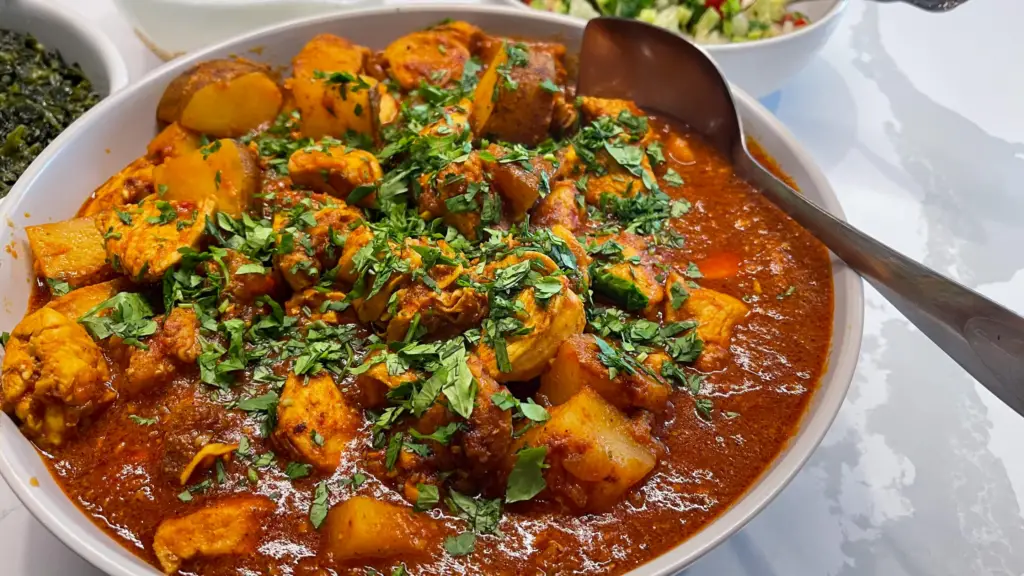
Korma, also known as Qorma, is a dish that has its roots in the Mughlai cuisine of the Indian subcontinent. It consists of meat or vegetables braised with yogurt, water or stock, and spices to produce a thick sauce or gravy. The dish can be traced back to the 16th century and the Mughal expansion into South Asia. Kormas were often prepared in the Mughal court kitchens, and the flavor of a korma is based on a mixture of spices, including ground coriander and cumin, combined with yogurt kept below curdling temperature and incorporated slowly and carefully with the meat juices.
Ingredients for Afghan Qorma
- Meat: Typically lamb, chicken, or beef.
- Yogurt: Used to give the gravy its creamy texture.
- Onions: Finely sliced or chopped.
- Garlic and Ginger: Minced or in paste form.
- Spices: Ground coriander, cumin, turmeric, and garam masala.
- Chili: Depending on the desired heat level.
- Tomatoes: Chopped or pureed.
- Oil or Ghee: For cooking.
- Water or Stock: For the gravy.
- Fresh Coriander: For garnishing.
Recipe for Afghan Qorma
- Sauté Onions: In a large pot, heat the oil or ghee and sauté the onions until they turn golden brown.
- Add Meat: Add the meat pieces and brown them on all sides.
- Add Spices: Add the garlic, ginger, and the ground spices. Sauté for a few minutes until fragrant.
- Add Tomatoes: Incorporate the tomatoes and cook until they break down and the oil separates from the mixture.
- Yogurt: Slowly add the yogurt, stirring continuously to prevent it from curdling.
- Simmer: Add water or stock, bring to a boil, then reduce the heat and let it simmer until the meat is tender and the gravy has thickened.
- Garnish: Garnish with fresh coriander before serving.
Serve the Qorma with Afghan bread or rice. Enjoy this rich and flavorful dish that is a testament to the culinary heritage of Afghanistan!
Afghan Cuisine – Sabzi (spinach and herb stew)
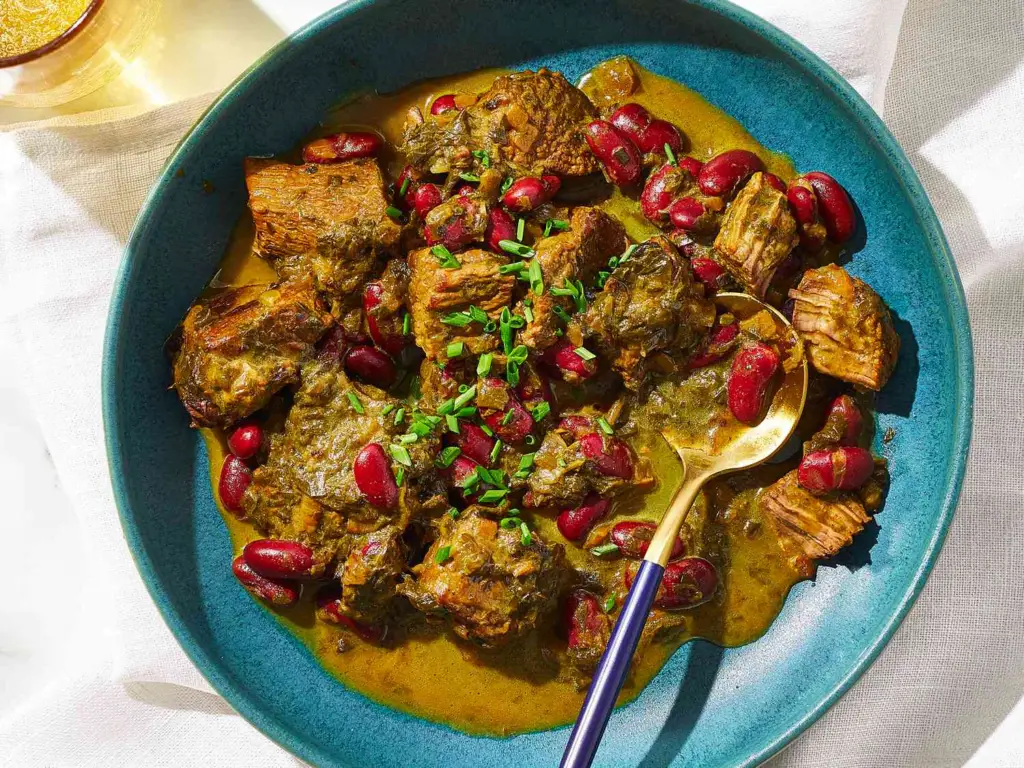
Afghan cuisine is a rich amalgamation of flavors influenced by Persian, Central Asian, and Indian cuisines due to Afghanistan’s geographical location and cultural ties. The cuisine is predominantly halal, with a focus on mutton, beef, poultry, and fish, accompanied by rice and Afghan bread. Fresh and dried fruits, dairy products, and vegetables are also integral to the Afghan diet. The national dish of Afghanistan is Qabili Palau, a rice dish cooked with raisins, carrots, nuts, and meat. The culinary specialties of Afghanistan reflect the nation’s ethnic and geographic diversity.
Afghan Cuisine – Sabzi (Spinach and Herb Stew)
Sabzi is a traditional Afghan dish made primarily of sautéed spinach and other greens. It is a type of qormah, which is an onion- and tomato-based stew or casserole. The process of making qormah involves caramelizing onions to achieve a richly colored stew, then adding tomatoes, various fruits, spices, and vegetables. The main ingredient, which can be meat or other vegetables, is added last. Sabzi specifically incorporates lamb and a mix of greens.
Afghan Cuisine – Sabzi Ingredients
- Spinach (main ingredient)
- Other greens (can include herbs like cilantro and dill)
- Lamb (optional)
- Onions
- Tomatoes
- Spices (as per preference)
Afghan Cuisine – Sabzi Recipe
- Start by caramelizing the onions in a pot until they turn a golden brown.
- Add tomatoes and cook until they soften.
- Add the lamb pieces (if using) and brown them on all sides.
- Incorporate the spinach and other greens, allowing them to wilt and mix well with the other ingredients.
- Add spices as per preference and let the stew simmer until all ingredients are well-cooked and flavors meld together.
- Serve with Afghan bread or rice.
Note: The exact recipe and proportions can vary based on personal preferences and regional variations.
Afghan Cuisine – Kabuli Pulao (Afghan national dish)
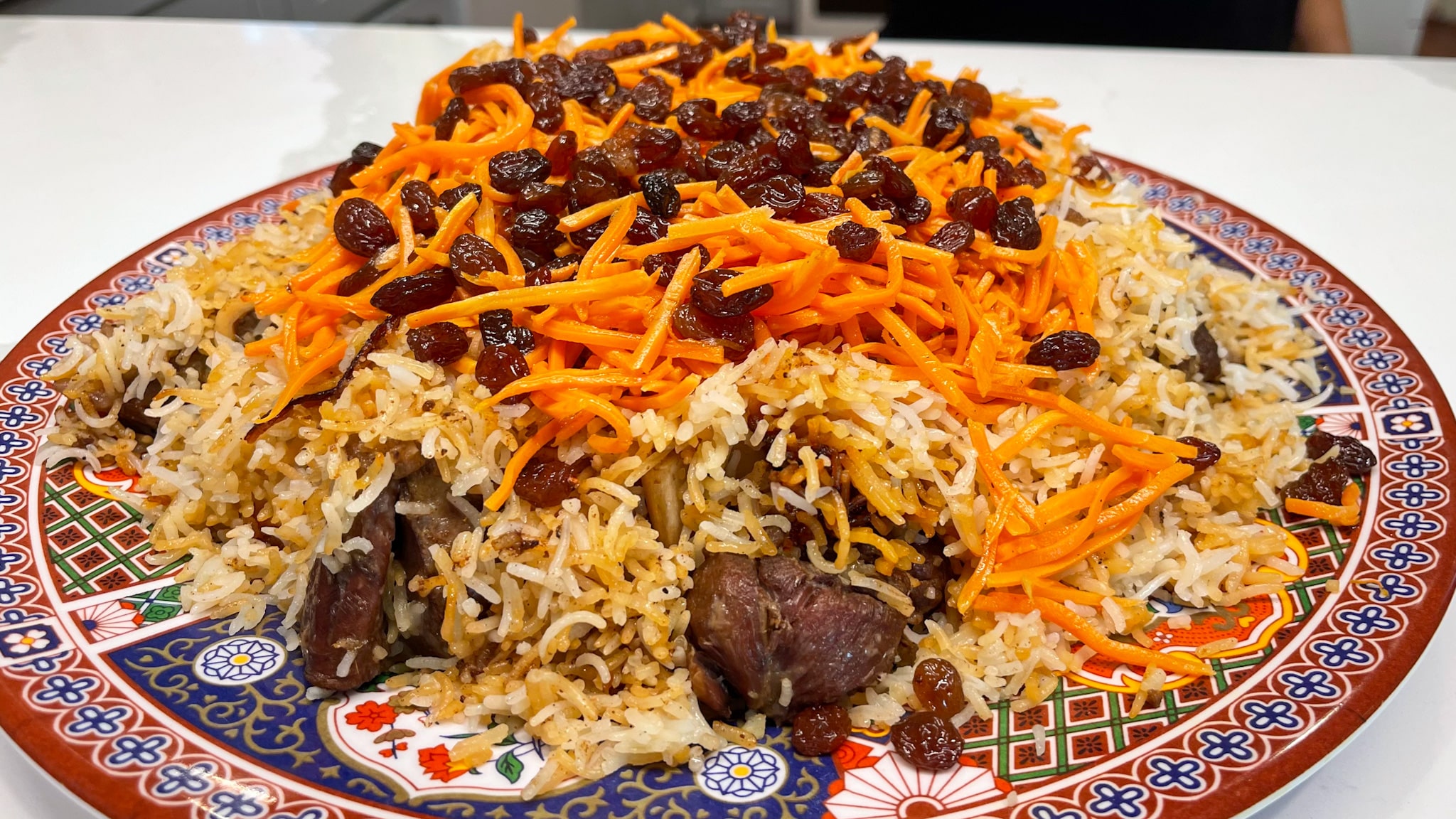
Kabuli Pulao is the Afghan national dish – a hearty and fragrant rice dish that combines caramelized carrots, raisins, and tender lamb or beef. It’s a perfect example of the unique blend of spices and flavors that make Afghan cuisine so delicious.
The dish is named after the capital city of Afghanistan, Kabul. The combination of sweet and savory elements, along with the fragrant spices, makes Kabuli Pulao, not only the Afghan national dish but also a favorite among many.
Afghan national dish – Kabuli Pulao Ingredients
- 2–4 tbsp char masala (recipe can be found on the source website)
- 2 teaspoons cumin seeds
- 1.5 lb lamb
- 350 grams julienned carrots
- 250 grams of raisins
- 1/4 C sesame oil
- 2 sliced onions
- 4 chopped garlic cloves
- Salt to taste
- 2 Tablespoons of sugar
- 3 Cups Rice
Afghan national dish – Kabuli Pulao Instructions
- Rinse the Rice: Ensure the water runs clear to remove starch.
- Soak the rice.
- Prepare the Lamb: Use an instant pot, pressure cooker, or regular pot.
- Add sesame oil and heat.
- Add onions and garlic.
- Cook briefly and then add cumin.
- Add the lamb, salt, and 3 cups of water.
- Cook until the meat is fork-tender.
Cook the rest
- Prepare Carrots and Raisins: In a pan, add vegetable oil and cook shredded carrots until soft. Remove and set aside.
- Soak raisins in hot water for about 5 minutes, drain, and cook in the same pan for about 30 seconds. Combine with the carrots.
Partially Cook the Rice: Boil a pot of salted water and add the soaked rice. - Cook for about 4 minutes or until you can break the rice with your finger. Drain.
- Prepare Sugar Solution: In a pan, add vegetable oil and sugar. Let the sugar darken, then add 1/2 cup of water and set aside.
Assembly
- Assemble: In a large pot, layer half of the rice, then the lamb, and then the remaining rice. Add some lamb broth, the sugar mixture, and char masala.
- Poke holes in the rice for steam to release. Place the packet of raisins and carrots on top of the rice.
- Cover and cook on medium-low heat for about 25 minutes.
The dish is traditionally served with salads and yogurt on the side. The combination of sweet raisins, savory meat, and aromatic rice makes Kabuli Pulao a delightful culinary experience.
Afghanistan Food – Kebabs
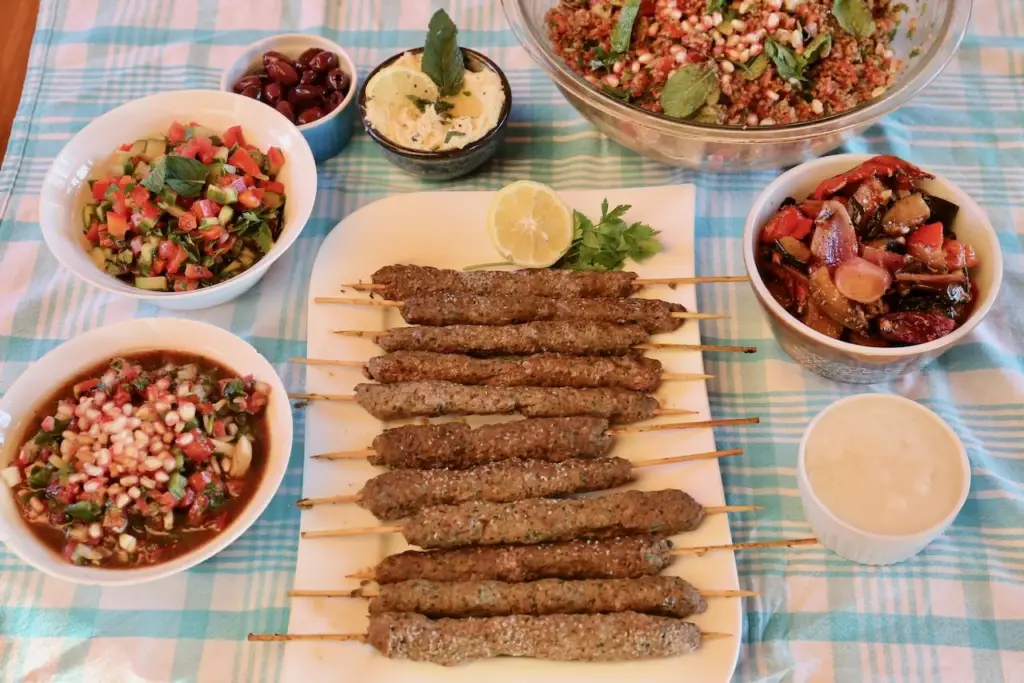
Afghan cuisine is influenced by Persian, Central Asian, and Indian cuisines due to Afghanistan’s close proximity and cultural ties. The cuisine is halal and mainly based on mutton, beef, poultry, and fish, accompanied by rice and Afghan bread. Fresh and dried fruits, such as apples, apricots, grapes, and pomegranates, are also integral to the diet. The national dish of Afghanistan is Qabili Palau, a rice dish cooked with raisins, carrots, nuts, and lamb or beef.
Afghan kebabs are commonly found in restaurants and at outdoor street vendor stalls. They often contain lamb meat and are served with naan instead of rice. Customers can choose to sprinkle sumac or ghora (dried ground sour grapes) on their kebabs.
Pieces of fat from the sheep’s tail (jijeq) are usually added to the skewers to enhance the flavor. Other popular kebabs include lamb chop, ribs, kofta (ground beef), and chicken.
Chapli kebab, a specialty of eastern Afghanistan, is a patty made of minced beef. It’s a popular barbecue dish in both Pakistan and Afghanistan. The original recipe for chapli kebab requires a half-meat, half-flour mixture, making it lighter in taste and more affordable.
Recipe for Afghan Kebabs: While the exact recipe can vary, here’s a basic recipe for Afghan kebabs:
Kebabs Ingredients:
- 500g lamb or beef, cut into chunks
- 2 onions, finely chopped
- 2-3 garlic cloves, minced
- 1-2 green chilies, finely chopped (optional)
- 1 tsp ground coriander
- 1 tsp ground cumin
- Salt and pepper to taste
- Fresh coriander leaves, chopped
- Lemon juice
- Vegetable oil for grilling
Instructions
- In a large bowl, combine the meat, onions, garlic, chilies, ground coriander, ground cumin, salt, and pepper. Mix well.
- Add the chopped fresh coriander and a squeeze of lemon juice. Mix again.
- Thread the meat chunks onto skewers.
- Heat a grill or barbecue. Brush the kebabs with a little oil and grill for 10-15 minutes, turning occasionally, until they are browned and cooked through.
- Serve hot with naan bread and a side of mint yogurt sauce or salad.
Afghanistan Food – Mantu
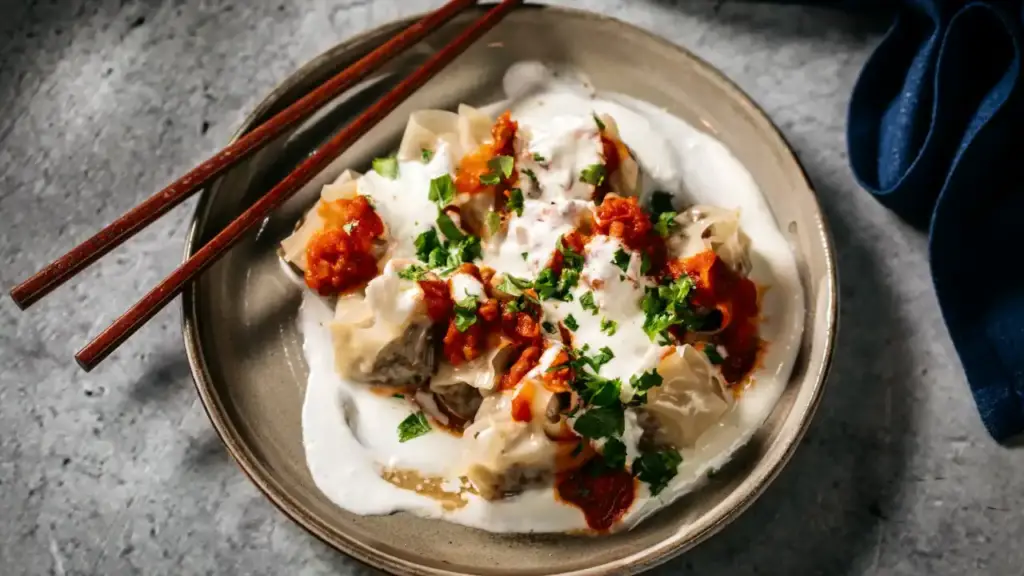
The cuisine is a rich tapestry of flavors and textures, influenced by the various ethnic groups and neighboring countries. One of the most beloved dishes in Afghanistan is Mantu, a type of dumpling filled with meat or vegetables. It’s a dish that showcases the Central Asian influence on Afghan cuisine.
Background on Mantu: Mantu is believed to have originated from Central Asia and was brought to Afghanistan by traders and travelers. These dumplings are similar to other dumplings found in Central and East Asian cuisines, such as the Chinese jiaozi or the Mongolian buuz. In Afghanistan, Mantu is often served at special occasions and gatherings, making it a cherished dish among many Afghans.
Recipe for Afghan Mantu
Afghan Cuisine – Mantu Ingredients
For the Filling:
- 500g ground beef or lamb
- 1 large onion, finely chopped
- 2 garlic cloves, minced
- 1 tsp ground coriander
- Salt and pepper to taste
- Fresh coriander leaves, chopped (optional)
The Dough
- 2 cups all-purpose flour
- 1/2 tsp salt
- About 3/4 cup water (or as needed)
For the Sauce:
- 1 cup plain yogurt
- 2 garlic cloves, minced
- Salt to taste
- Dried mint (optional)
For the Topping:
- Tomato sauce or tomato paste
- Dried mint
- Red chili powder (optional)
Instructions
- Prepare the Filling: In a large bowl, combine the ground meat, chopped onion, minced garlic, ground coriander, salt, pepper, and fresh coriander (if using). Mix well and set aside.
- Prepare the Dough: In another bowl, mix the flour and salt. Gradually add water and knead to form a smooth dough. Cover and let it rest for about 30 minutes.
- Make the Dumplings: Roll out the dough on a floured surface to a thin sheet. Cut out circles using a round cutter or a glass. Place a small amount of the meat filling in the center of each circle. Fold the dough over the filling to form a half-moon shape and seal the edges by pinching them together. You can also gather the edges at the top to form a small pouch.
- Cook the Mantu: Steam the dumplings in a steamer for about 20-25 minutes or until the meat is cooked through and the dough is tender.
- Prepare the Sauce: Mix the plain yogurt with minced garlic, salt, and dried mint (if using). Set aside.
- Serve: Place the steamed Mantu on a serving dish. Top with the yogurt sauce, a drizzle of tomato sauce or paste, a sprinkle of dried mint, and red chili powder (if using).
Mantu is traditionally served with a side of salad and pickles. Enjoy this delicious Afghan delicacy!
Afghanistan Food – Cuisine – Ashak
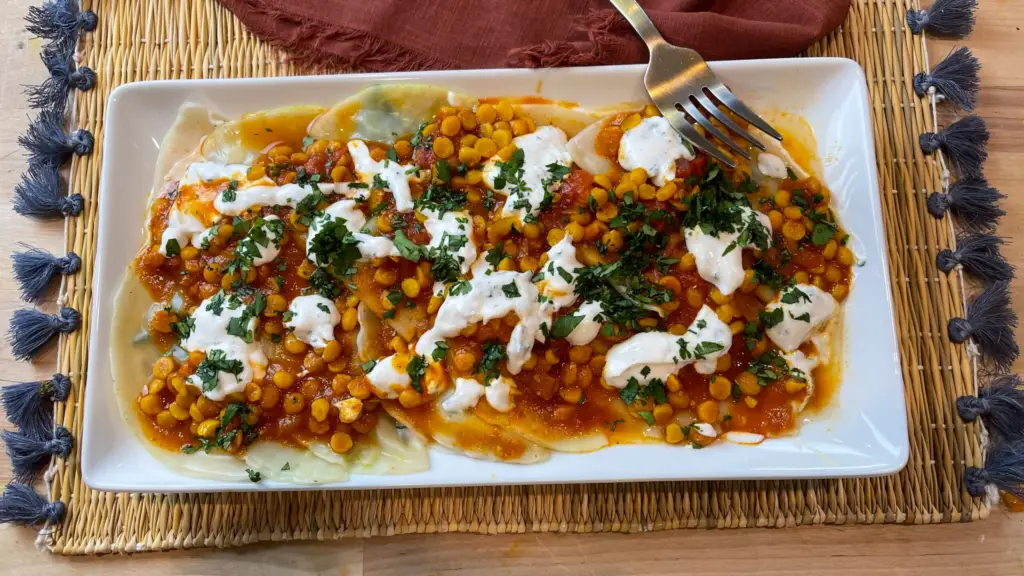
Aushak, also known as Ashak, is a traditional Afghan dish that originates from Afghanistan. It consists of pasta dumplings filled with chives and is typically topped with a tomato sauce, which can sometimes be meaty.
The dish is then garnished with yogurt and dried mint. Aushak is a time-consuming meal to prepare and is often reserved for special occasions, holidays, or gatherings. It bears a resemblance to another popular Afghan dish, mantu, but while mantu is filled with meat, aushak is distinctively filled with chives.
Ingredients for Aushak
- Pasta dumplings: These are the primary component of the dish.
- Chives: Used as the main filling for the dumplings.
- Tomato sauce: Can be meaty or vegetarian, depending on preference.
- Yogurt: Used as a topping.
- Dried mint: Used for garnishing.
Recipe for Aushak
While the exact recipe can vary, here’s a basic recipe for Aushak:
- Prepare the Filling: Finely chop the chives and set them aside.
- Make the Dumplings: Prepare a pasta dough and roll it out thinly. Cut into small circles. Place a small amount of chives in the center of each circle, fold, and seal the edges.
- Cook the Aushak: Boil the dumplings in salted water until they rise to the surface and are cooked through.
- Prepare the Tomato Sauce: In a pan, sauté onions until translucent. Add tomatoes and cook until they break down into a sauce. Season with salt, pepper, and other desired spices. You can also add ground meat to the sauce if you prefer.
- Serve: Place the cooked Aushak on a plate, pour the tomato sauce over them, and top with yogurt. Sprinkle dried mint on top for garnish.
Enjoy this traditional Afghan delicacy!
Afghanistan Food – Borani Banjan

Borani Banjan is a vegetarian dish of fried eggplant that’s simmered in a tangy tomato sauce and topped with a garlic yogurt sauce. It’s a perfect side dish or light meal and showcases the vibrant flavors and fresh ingredients that are the hallmark of Afghan cuisine.
If you’re looking for authentic Afghan cuisine, these dishes are a great starting point. They offer a taste of the unique flavors and traditional cooking techniques that make Afghan cuisine so special. So, grab a plate and experience the authentic taste of Afghanistan!
Borani Banjan is a popular dish in Afghan cuisine that features layers of fried eggplant covered in a tangy tomato sauce and topped with a garlic-infused yogurt sauce. It’s often served as a side dish or appetizer and is a staple in many Afghan households. The dish showcases the rich flavors and textures of Afghan cooking, blending the softness of the eggplant with the acidity of the tomatoes and the creaminess of the yogurt.
Afghan Cuisine – Borani Banjan Ingredients
- Eggplants (sliced)
- Tomatoes (chopped or pureed)
- Garlic (minced)
- Yogurt (preferably thick, like Greek yogurt)
- Turmeric, salt, and pepper (for seasoning)
- Fresh coriander or mint (for garnish)
- Oil (for frying)
Afghan Cuisine – Borani Banjan Recipe
- Prepare the Eggplant: Slice the eggplants and sprinkle them with salt. Let them sit for about 30 minutes to draw out moisture. Pat them dry.
- Fry the Eggplant: Heat oil in a pan and fry the eggplant slices until they are golden brown on both sides. Remove and set them on a plate lined with paper towels to drain excess oil.
- Prepare the Tomato Sauce: In the same pan, add a bit more oil if needed and sauté garlic until fragrant. Add the tomatoes, turmeric, salt, and pepper. Cook until the tomatoes break down and the sauce thickens.
- Layer the Dish: In a serving dish, layer the fried eggplant slices and pour the tomato sauce over them.
- Prepare the Yogurt Sauce: In a separate bowl, mix yogurt with minced garlic, salt, and a bit of water to get a smooth consistency.
- Serve: Pour the yogurt sauce over the eggplant and tomato layers. Garnish with fresh coriander or mint. Serve with Afghan bread or rice.
Enjoy your Borani Banjan! This dish is a delightful combination of flavors and textures that truly represents the essence of Afghan cuisine.
Afghanistan Food – Firni
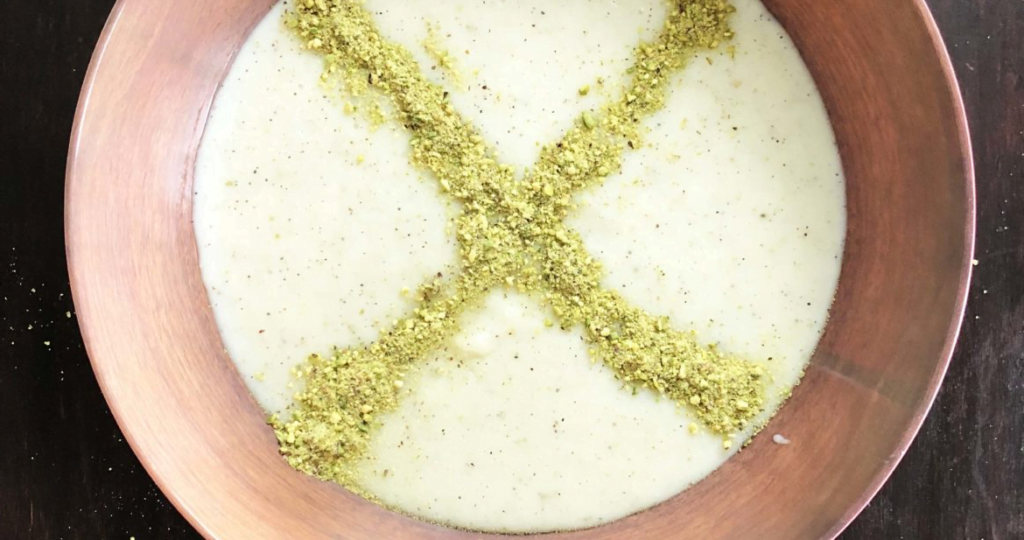
Firni, also known as Phirni in some regions, is a traditional dessert popular in the Indian subcontinent, including Afghanistan. It is a type of rice pudding made by boiling milk with ground rice, sugar, and flavorings. The dish is creamy in texture and is often flavored with cardamom, saffron, and garnished with nuts. In Afghanistan, Firni holds a special place during festive occasions and gatherings.
Ingredients for Firni:
- Rice: Preferably basmati rice, soaked for a few hours and then ground to a paste.
- Milk: Full-fat milk is preferred for a creamy texture.
- Sugar: Adjust to taste.
- Cardamom: Ground cardamom adds a fragrant aroma.
- Saffron: A few strands for flavor and color (optional).
- Nuts: Almonds, pistachios, or cashews for garnish.
- Rosewater: A few drops for added fragrance (optional).
Recipe for Firni:
- Prepare Rice Paste: Soak the rice in water for a few hours. Drain the water and grind the rice to a smooth paste using a little water.
- Boil Milk: In a heavy-bottomed pan, bring the milk to a boil. Reduce the heat to low.
- Add Rice Paste: Slowly add the rice paste to the boiling milk, stirring continuously to avoid lumps.
- Cook: Continue to cook on low heat, stirring frequently, until the mixture thickens.
- Add Sugar and Flavorings: Once the mixture has thickened, add sugar, ground cardamom, and saffron (if using). Cook for another 5-10 minutes.
- Cool and Garnish: Remove from heat and let it cool. Once cooled, pour the Firni into serving bowls or clay pots. Garnish with sliced nuts.
- Chill: Refrigerate for a few hours before serving. Firni is best enjoyed chilled.
Enjoy this delightful Afghan dessert that offers a creamy and aromatic experience!
Afghanistan Food – Sheer Birinj

Firni, also known as Phirni in some regions, is a traditional dessert popular in the Indian subcontinent, including Afghanistan. It is a type of rice pudding made by boiling milk with ground rice, sugar, and flavorings. The dish is creamy in texture and is often flavored with cardamom, saffron, and garnished with nuts. In Afghanistan, Firni holds a special place during festive occasions and gatherings.
Ingredients for Firni:
- Rice: Preferably basmati rice, soaked for a few hours and then ground to a paste.
- Milk: Full-fat milk is preferred for a creamy texture.
- Sugar: Adjust to taste.
- Cardamom: Ground cardamom adds a fragrant aroma.
- Saffron: A few strands for flavor and color (optional).
- Nuts: Almonds, pistachios, or cashews for garnish.
- Rosewater: A few drops for added fragrance (optional).
Recipe for Firni:
- Prepare Rice Paste: Soak the rice in water for a few hours. Drain the water and grind the rice to a smooth paste using a little water.
- Boil Milk: In a heavy-bottomed pan, bring the milk to a boil. Reduce the heat to low.
- Add Rice Paste: Slowly add the rice paste to the boiling milk, stirring continuously to avoid lumps.
- Cook: Continue to cook on low heat, stirring frequently, until the mixture thickens.
- Add Sugar and Flavorings: Once the mixture has thickened, add sugar, ground cardamom, and saffron (if using). Cook for another 5-10 minutes.
- Cool and Garnish: Remove from heat and let it cool. Once cooled, pour the Firni into serving bowls or clay pots. Garnish with sliced nuts.
- Chill: Refrigerate for a few hours before serving. Firni is best enjoyed chilled.
Enjoy this delightful Afghan dessert that offers a creamy and aromatic experience!
Afghanistan Food – Sweet and Nutty Sheer Yakh
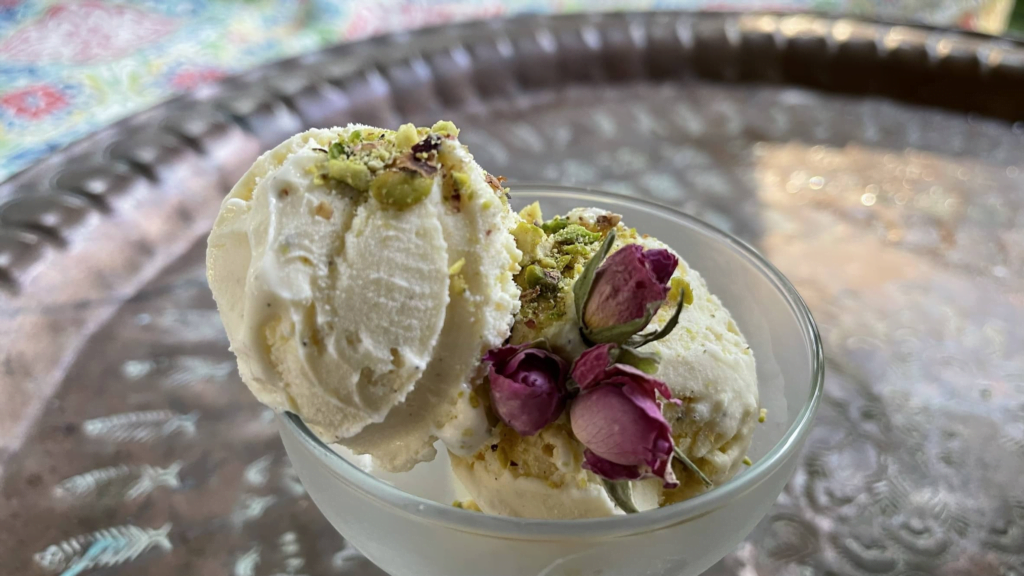
Sheer Yakh is a traditional Afghan dessert that translates to “cold milk.” It is a type of wet ice cream that is enjoyed especially during the warmer months. As with many Afghan dishes, Sheer Yakh is made with natural ingredients and often includes flavors such as cardamom and rose water. It is typically served in a semi-frozen state, making it a refreshing treat. The dessert is often garnished with pistachios and sometimes other nuts.
Ingredients
Unfortunately, the specific list of ingredients for Sheer Yakh is hard to come by. However, based on traditional recipes, the following are the common ingredients used:
- Whole milk
- Sugar
- Cardamom
- Rose water
- Pistachios (for garnish)
- Other nuts (optional for garnish)
Recipe
- In a saucepan, heat the milk until it is warm but not boiling.
- Add sugar to the milk and stir until it is completely dissolved.
- Add cardamom and rose water to the mixture and stir well.
- Allow the mixture to cool to room temperature.
- Once cooled, pour the mixture into a shallow dish and place it in the freezer.
- After about an hour, when the mixture starts to solidify, stir it well and return it to the freezer.
- Repeat the stirring process every 30 minutes until the ice cream is fully set but still a bit slushy in consistency.
- Serve in bowls or glasses, garnished with pistachios and other nuts if desired.
Enjoy your traditional Afghan Sheer Yakh!
Note: The above recipe is a general guideline based on traditional methods of making Sheer Yakh. There might be variations in the recipe depending on the region or family traditions in Afghanistan.
Whether you’re a fan of sweet or savory, Afghan desserts are sure to tempt your taste buds. They offer a glimpse into the rich cultural heritage of Afghanistan and a delicious end to any meal.
Conclusion
I hope that this culinary journey through the flavors and traditions of Afghan cuisine has left you feeling inspired and excited to try your hand at cooking some authentic Afghan dishes. From the staple ingredients to the traditional recipes and street food delights, Afghan cuisine has so much to offer.
As I mentioned earlier, the Afghan kitchen is not just a space for cooking but also a hub of hospitality and warmth. It’s a place where family and friends gather to share meals and create memories. By bringing Afghan flavors into your own kitchen, you’re not just experiencing the taste of a unique cuisine but also embracing the warmth and hospitality of Afghan culture.
So go ahead and experiment with different spices, try out some new recipes, and don’t be afraid to make them your own. Whether it’s a hearty meat dish or a sweet dessert, every bite tells a story of Afghanistan’s rich cultural heritage.
Thank you for joining me on this journey of discovery, and I can’t wait to hear about your own culinary adventures as you explore the authentic taste of Afghanistan.
FAQ’s
What is Afghan cuisine?
Afghan cuisine refers to the traditional food and cooking practices of Afghanistan. It is known for its bold flavors, aromatic spices, and diverse range of dishes.
What are the characteristics of Afghan Cuisine Recipes
Afghan cuisine recipes feature a rich blend of spices and flavors, reflecting the country’s cultural diversity. Popular dishes include kabobs, qabuli pulao (rice with meat and carrots), and mantu (steamed dumplings). These recipes often showcase the traditional use of ingredients like lamb, yogurt, and rice, creating a unique and delicious culinary experience.
What is the Afghan National Dish?
Kabuli Pulao is the national dish of Afghanistan. This flavorful rice dish is made with basmati rice, tender meat, and a blend of aromatic spices.
It is often garnished with raisins, carrots, and almonds, and is a staple in Afghan cuisine.
What are some popular Afghan dishes?
Some popular Afghan dishes include Kabuli Pulao, Ashak, Mantu, and Kebabs. These dishes showcase the unique flavors and culinary expertise of Afghan cuisine.
What are the staple ingredients in Afghan cuisine?
Staple ingredients in Afghan cuisine include fragrant spices like cardamom and cumin, as well as staple grains like rice and wheat. These ingredients form the foundation of many Afghan recipes.
Can I recreate authentic Afghan dishes at home?
Absolutely! With the right ingredients and recipes, you can recreate authentic Afghan dishes in your own kitchen. We’ll provide tips and tricks to help you bring the flavors of Afghanistan to your table.
How has Afghan cuisine influenced the world?
Afghan cuisine has had a significant influence on neighboring regions and beyond. Its flavors and cooking techniques can be seen in the cuisines of Persian, Central Asian, and Indian cuisines, among others.
What is the cultural significance of the Afghan kitchen?
The Afghan kitchen is not just a space for cooking, but also a symbol of hospitality and warmth. It is where meals are prepared and shared, bringing families and communities together.
Where can I find Afghan street food?
Afghan street food can be found in bustling streets and markets in Afghanistan. From savory snacks like Bolani to sweet treats like Jalebi, these street food delights are a must-try for food lovers.
What are some popular Afghan desserts?
Afghan desserts are a celebration of flavors and often feature ingredients like rosewater, pistachios, and cardamom. Some popular Afghan desserts include Sheer Khurma, Firnee, and Gulab Jamun.
Can you recommend some authentic Afghan recipes?
Certainly! We’ll share the secrets behind classic Afghan recipes like Mantu, Ashak, and Borani Banjan. Follow along and learn how to create these delicious dishes in your own kitchen.
How do I bring Afghan flavors into my kitchen?
We’ll provide tips and tricks for recreating authentic Afghan flavors at home. From sourcing the right ingredients to mastering the cooking techniques, you’ll be able to bring the taste of Afghanistan to your recipes.
Last Edited

